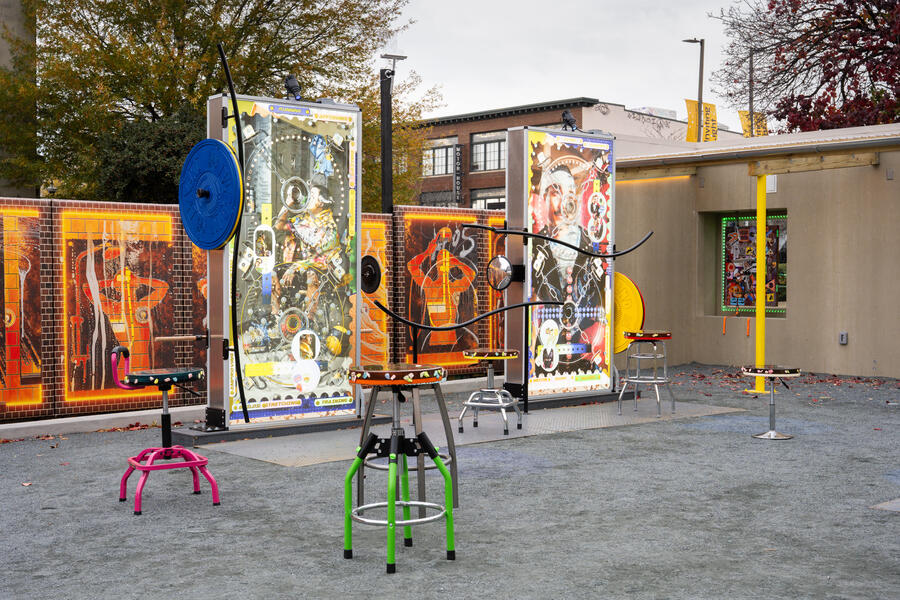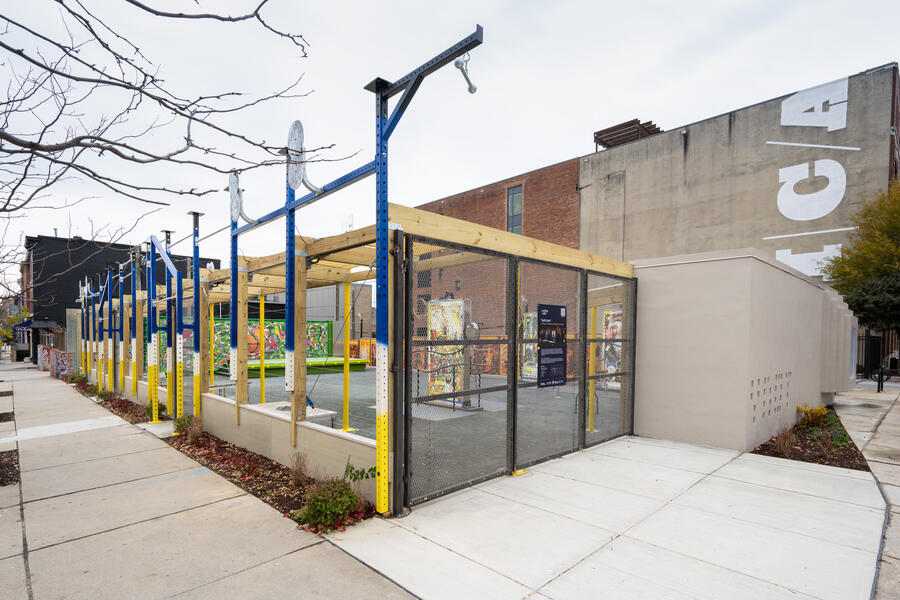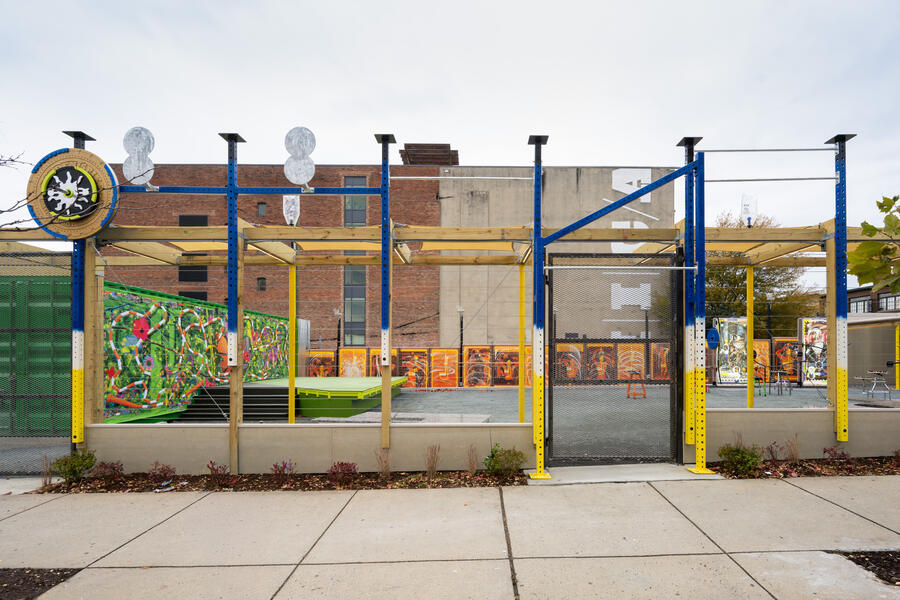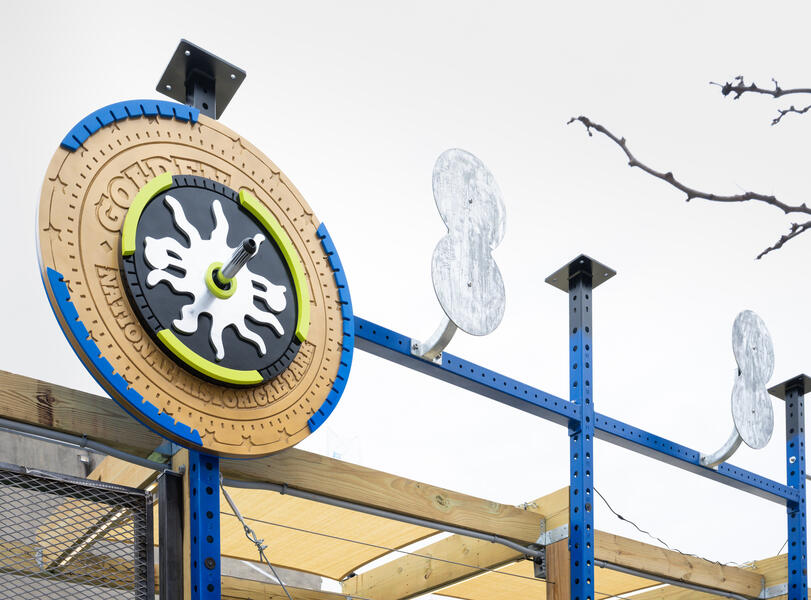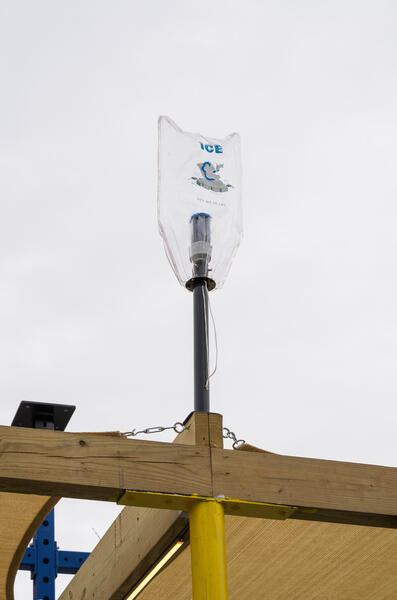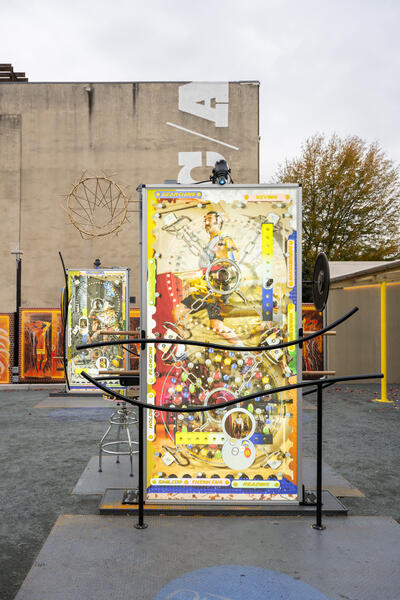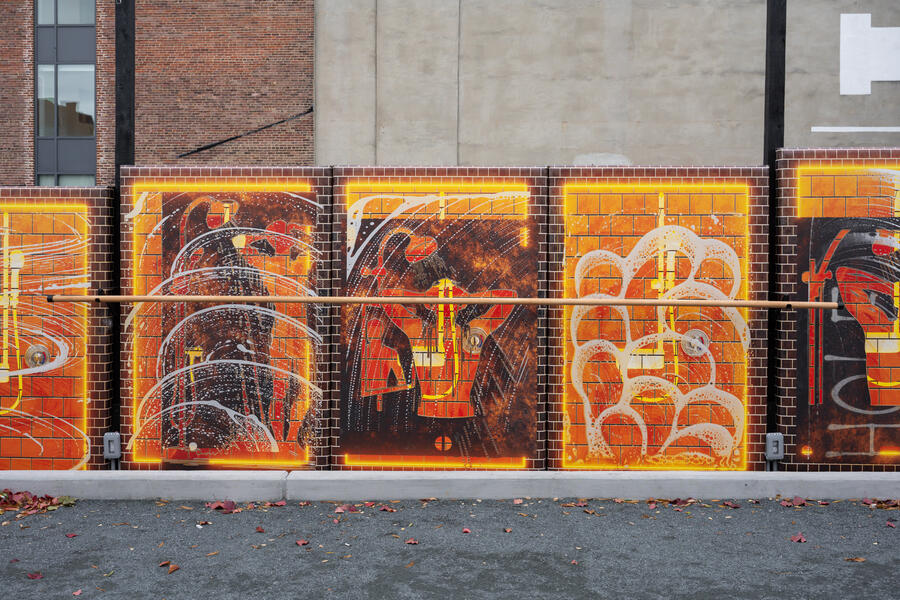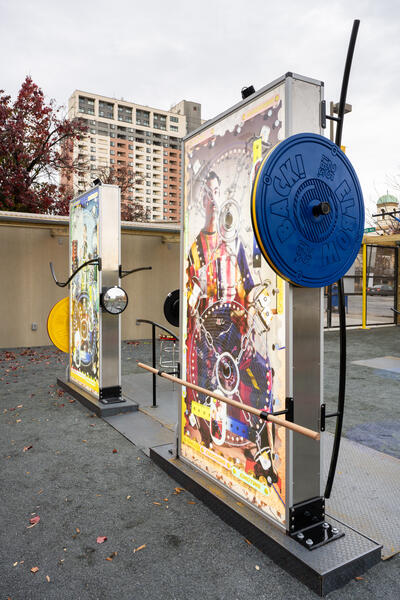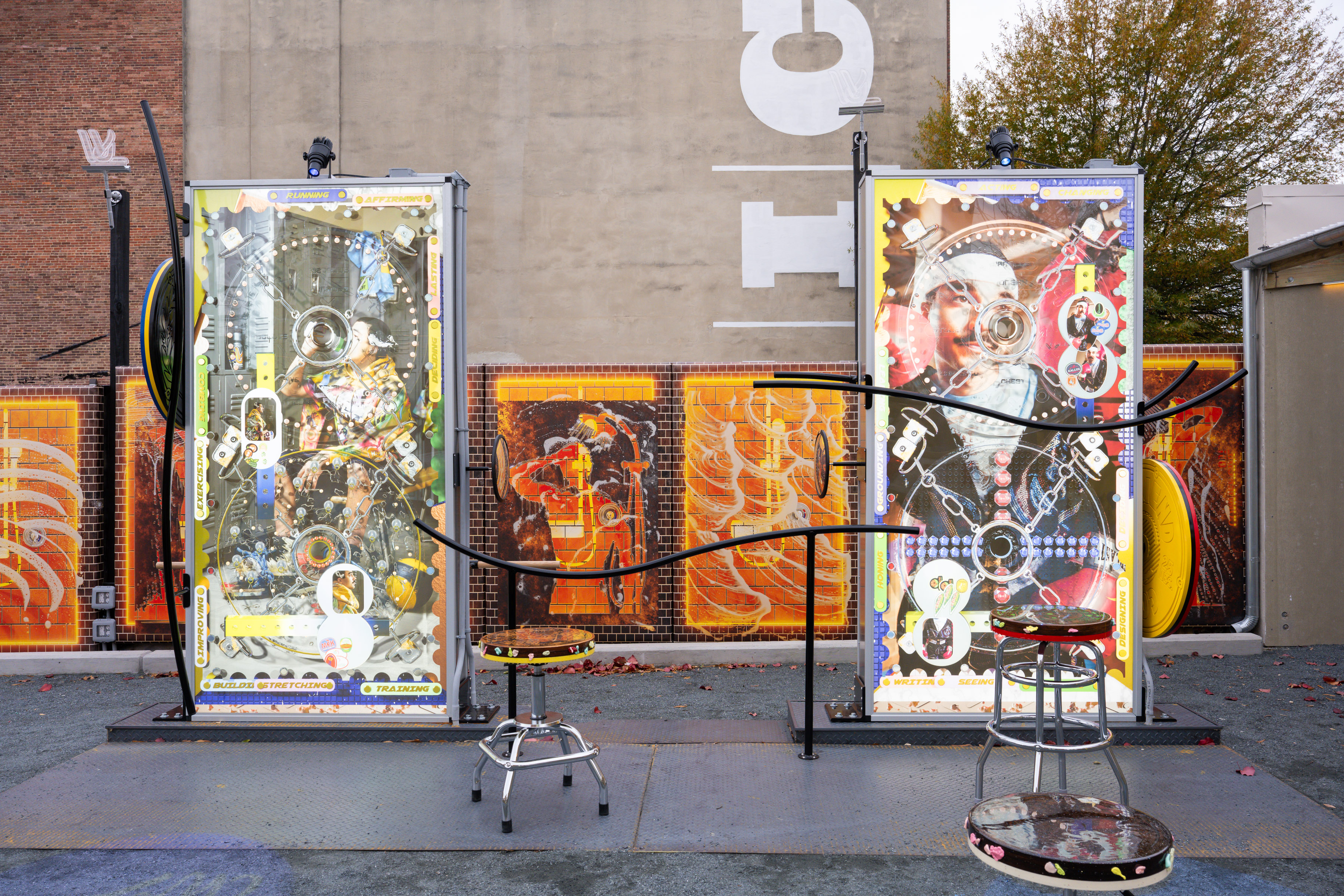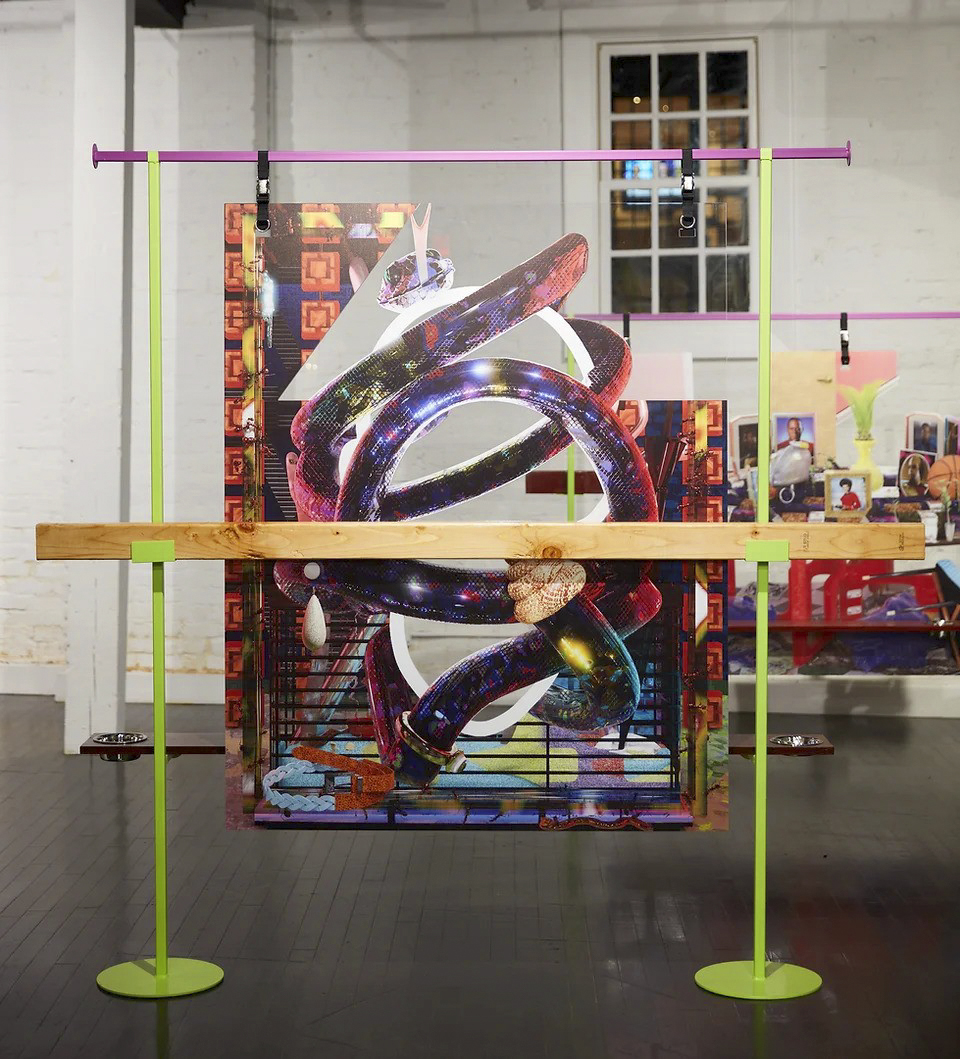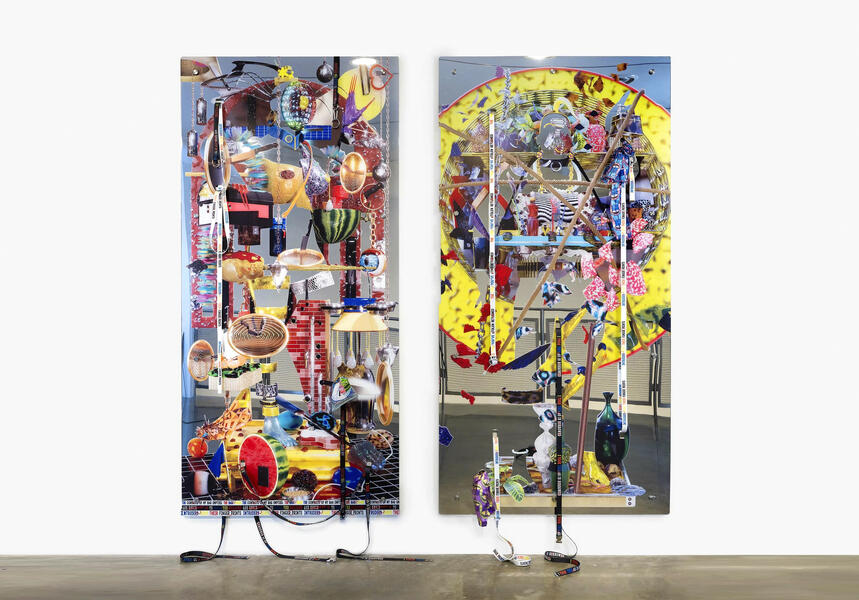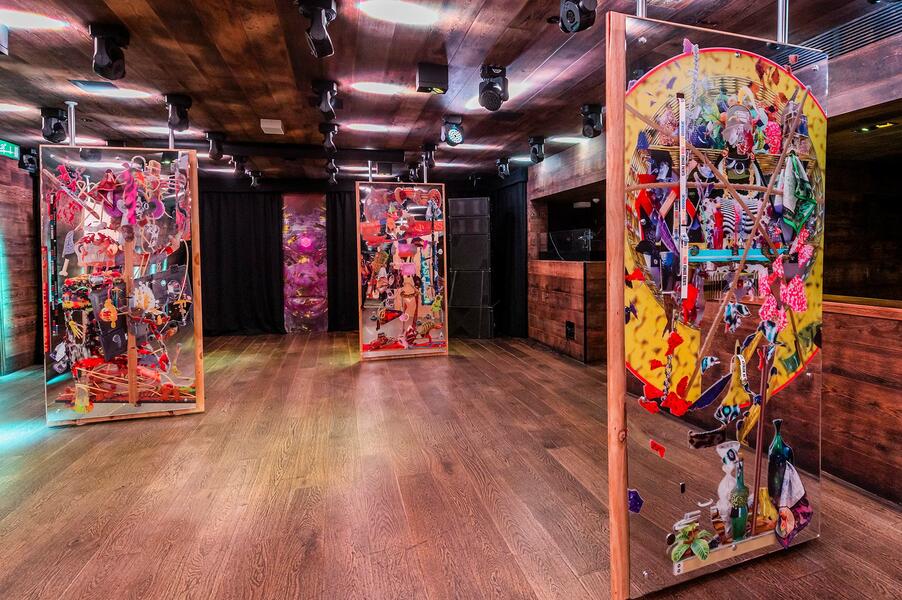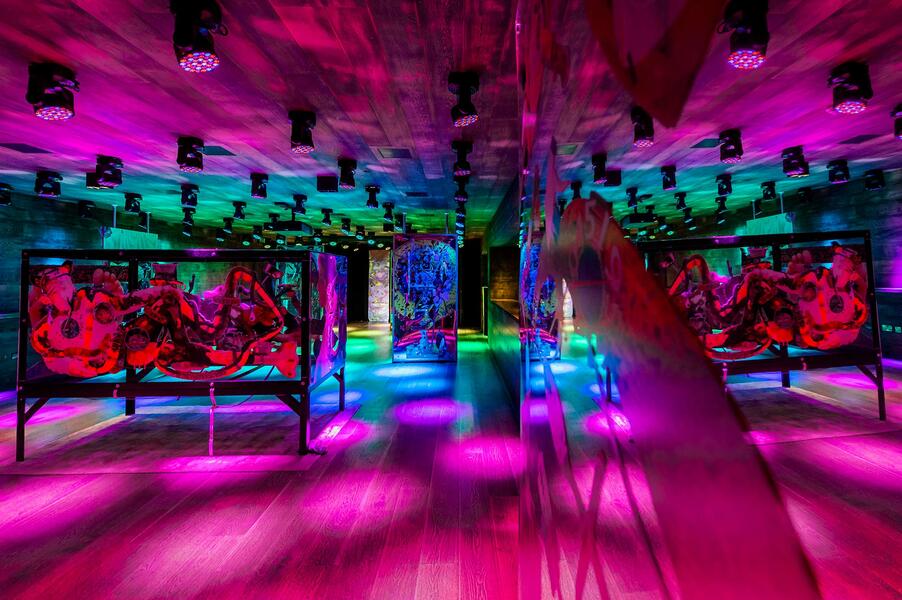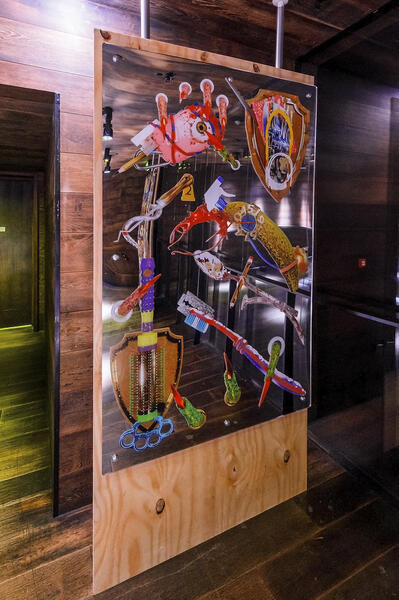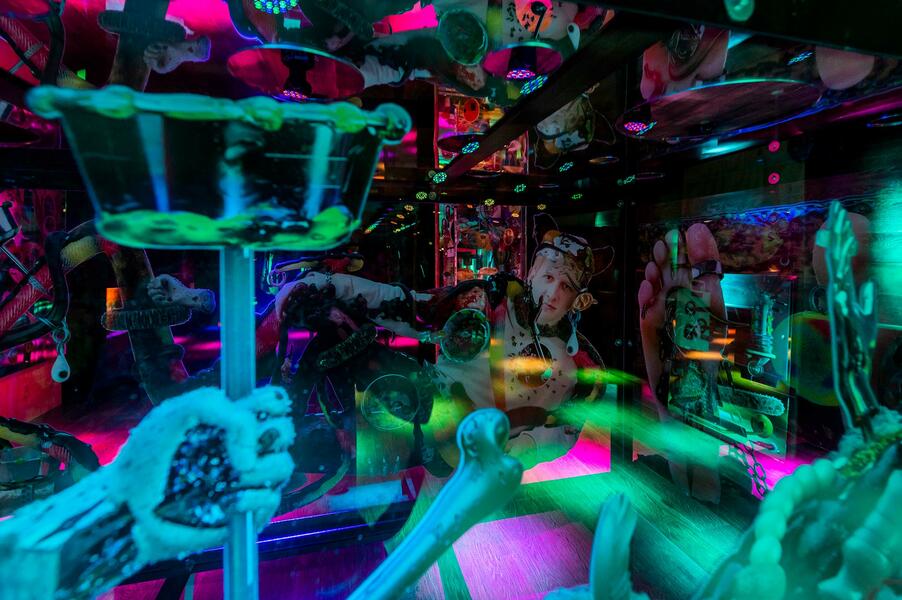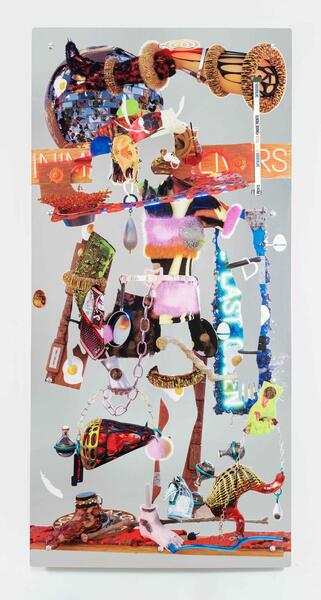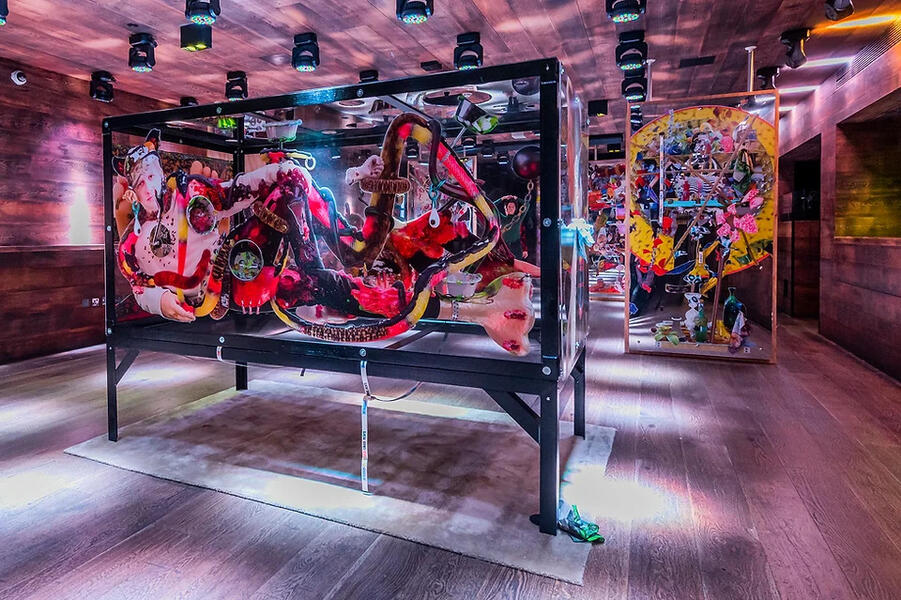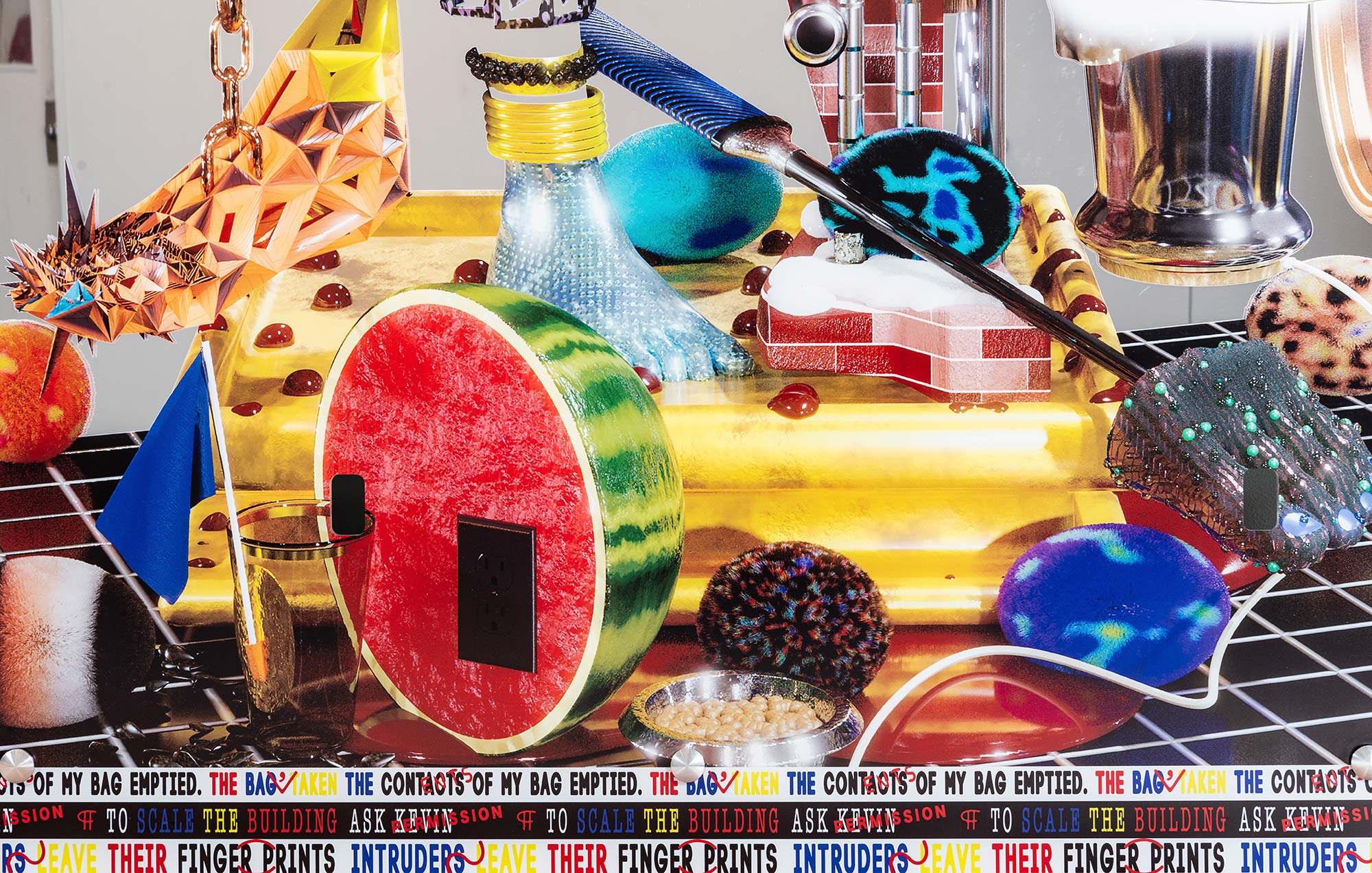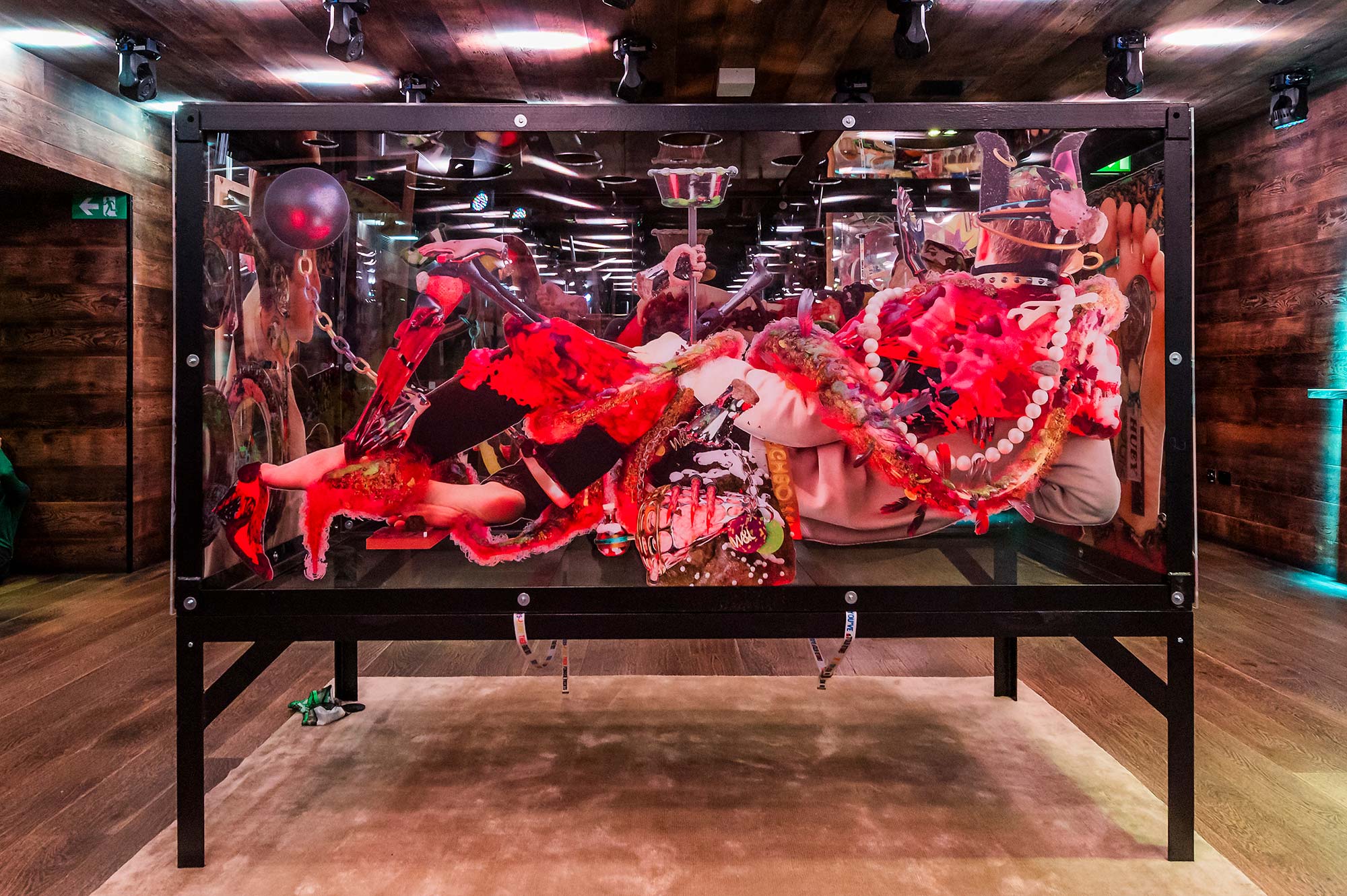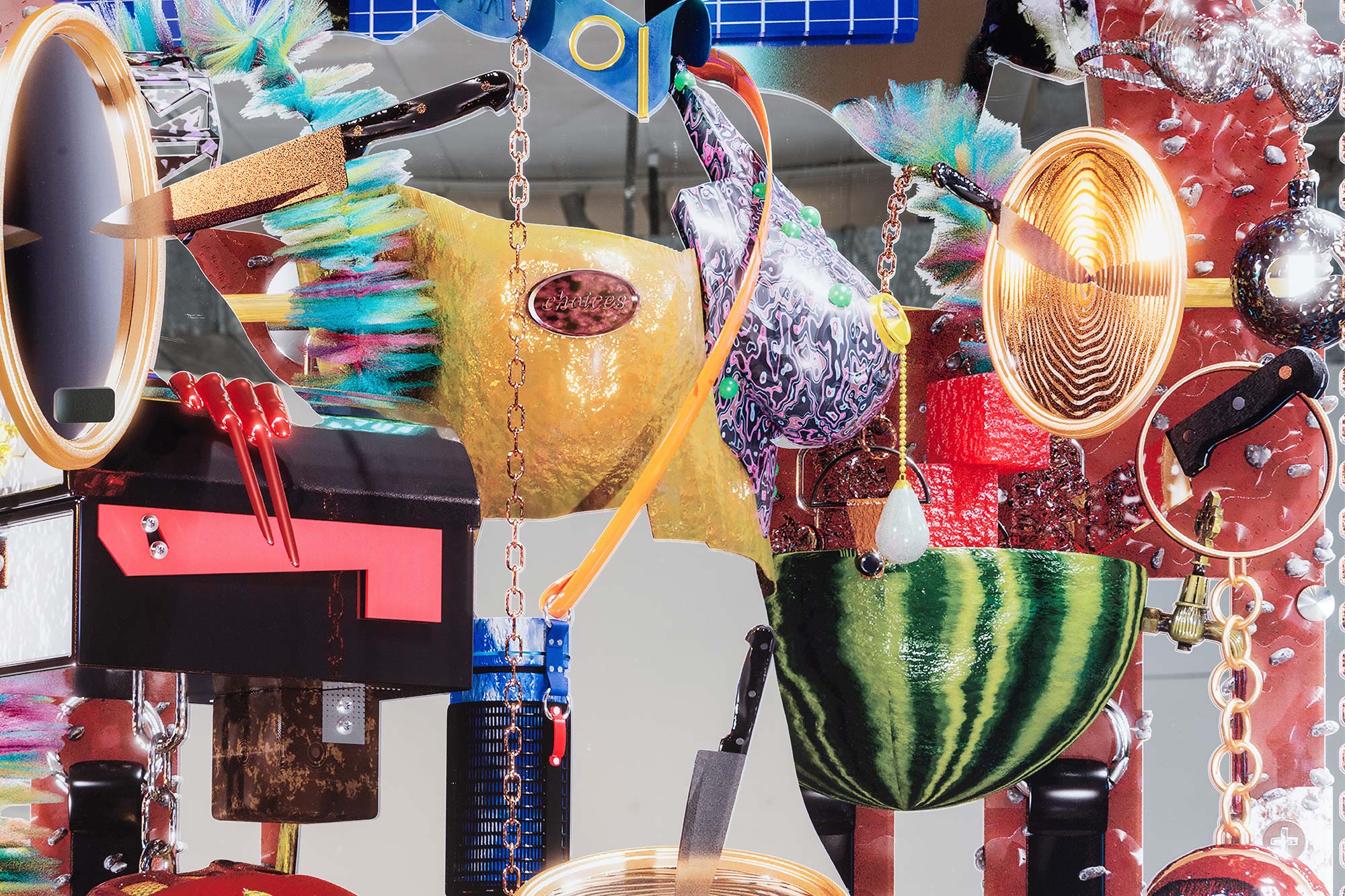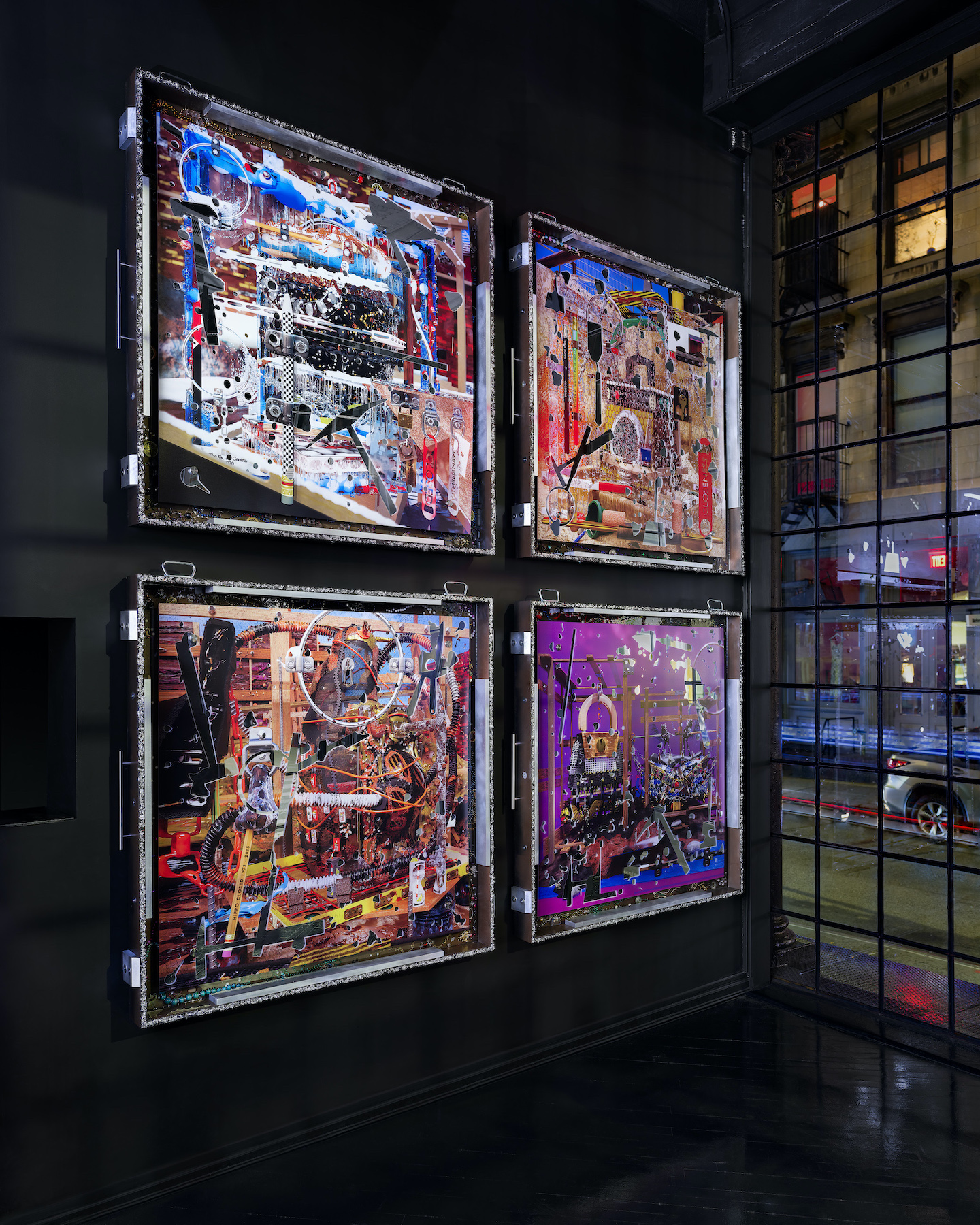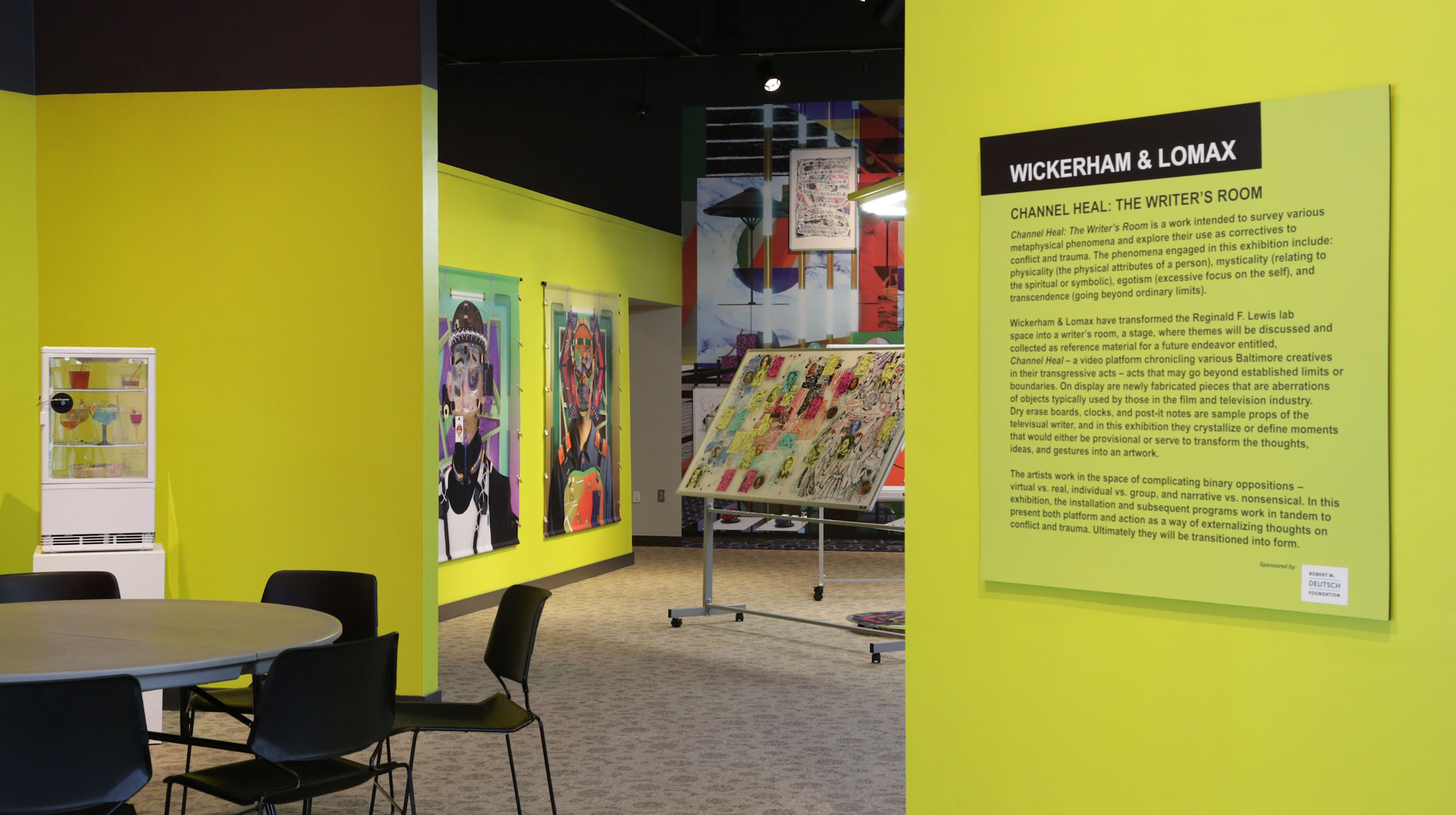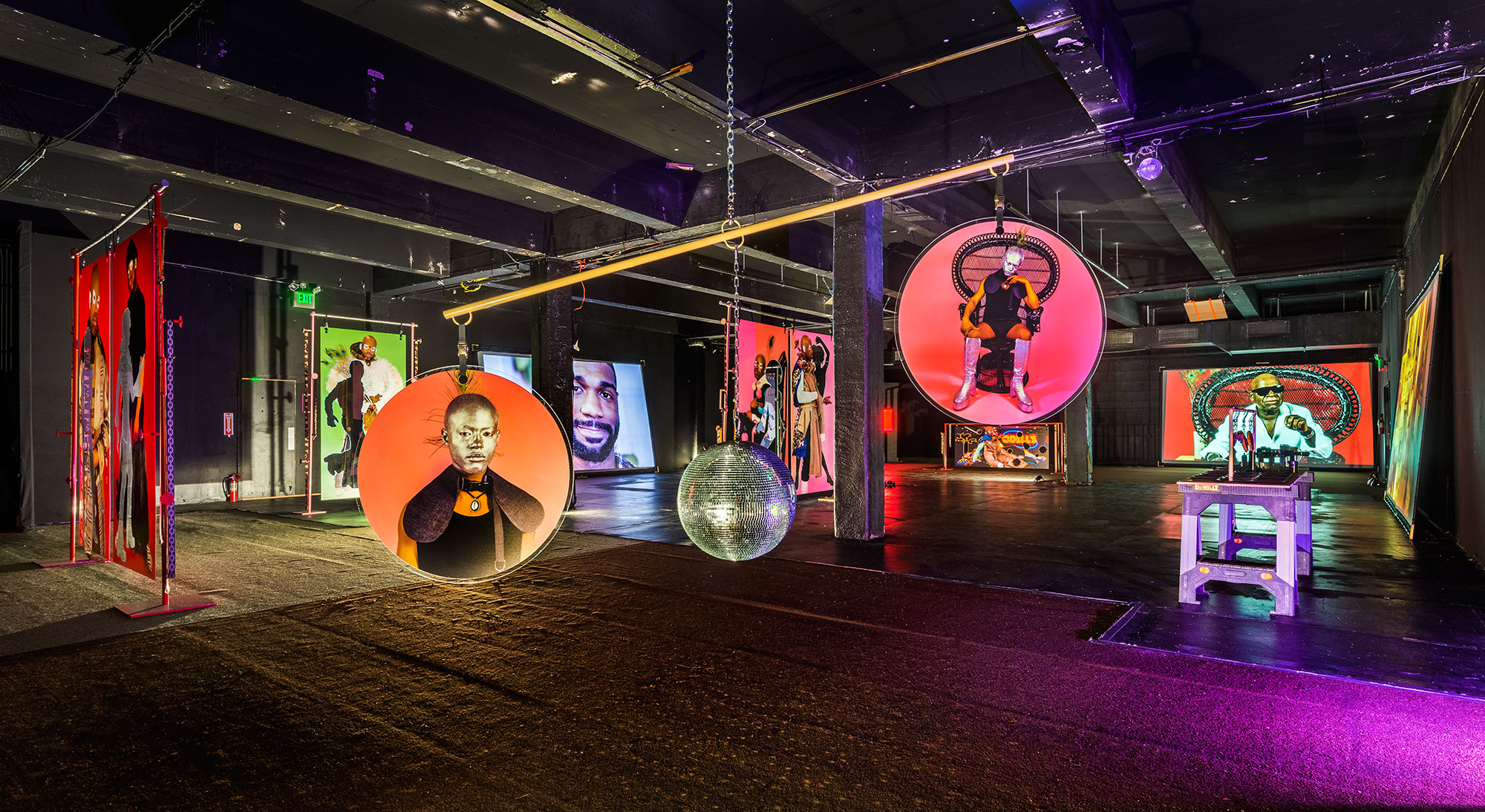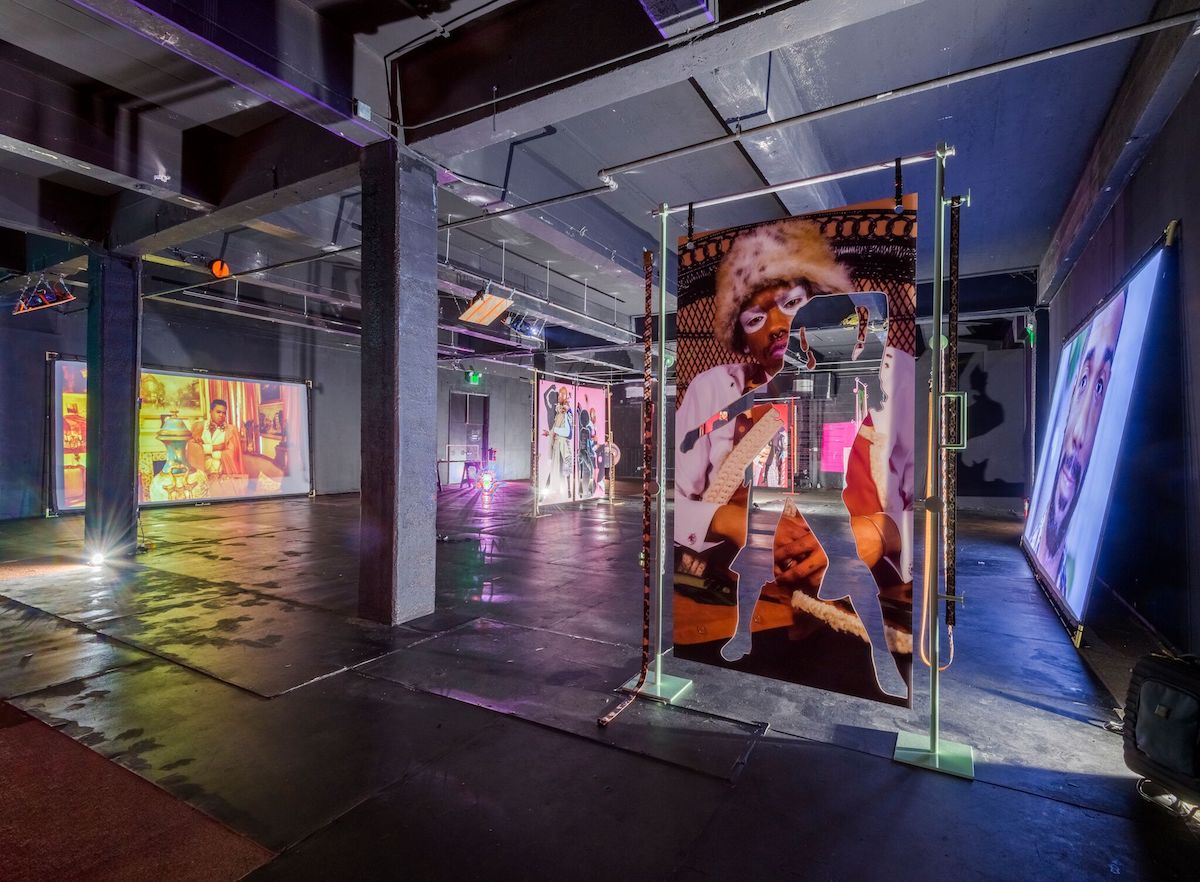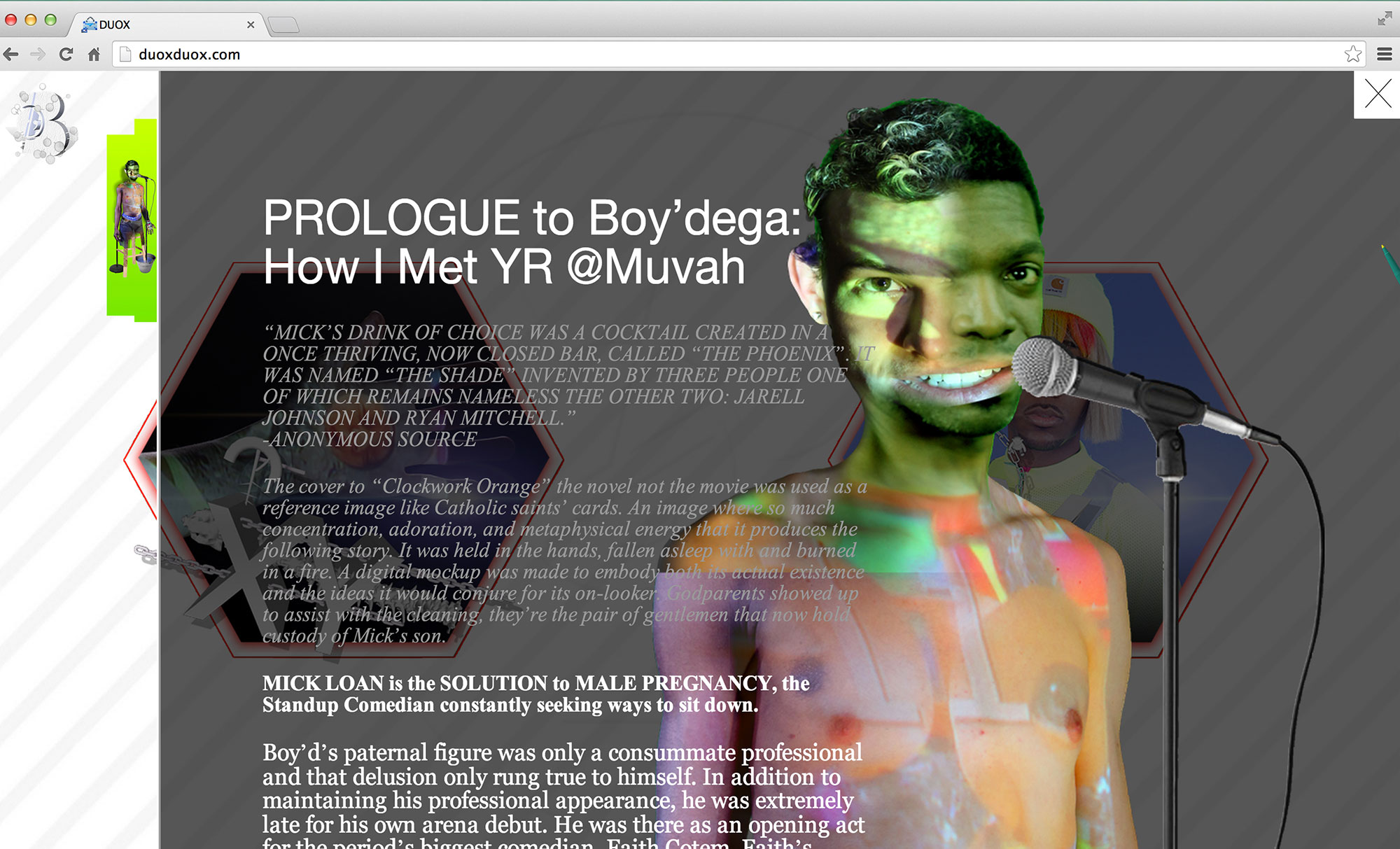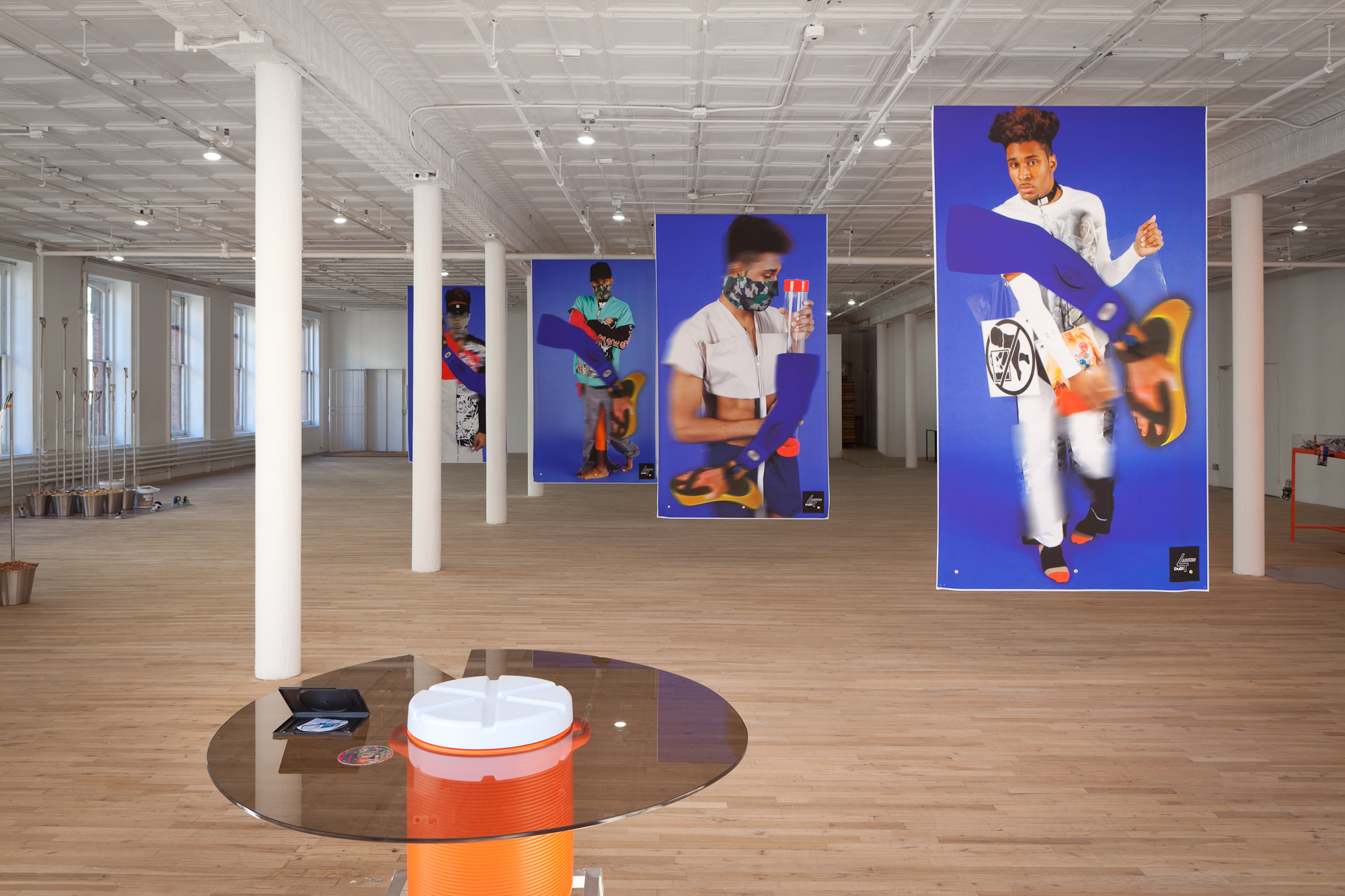Work samples
-
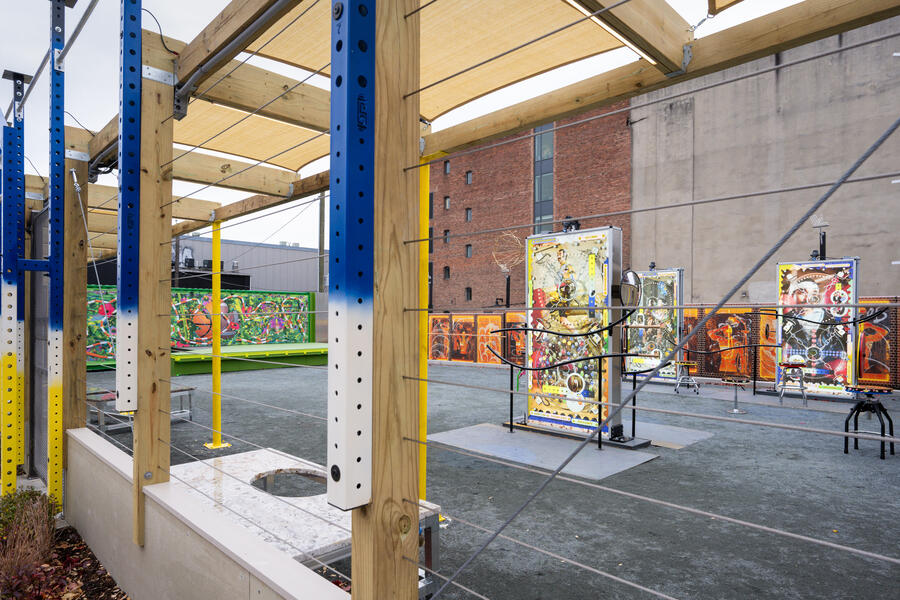 SOFT GYM
SOFT GYMSoft Gym replaces the view of a park with the act of moving through one: touching, leaning, resting, sweating. Between a grandmother's reminder to never forget where you come from and a mother's call to reinvent yourself, the work finds its rhythm in that tension-what's inherited stretching toward what's made.
The gym became a gem through pressure-of planning, of corre-spondence, of care-where softness works as both method and mood, keeping form open yet durable.
Its padded walls and gym rigs translate private gestures into public form; they remember contact the way the body remembers use.
The work translates the physical into the visual, pairing Baltimore's vernacular inventiveness with art-historical echoes-from tondos of Madonna and Child to Richard Serra's 'Tilted Arc.'
Here, feeling behaves. Manners count as a kind of muscle. Vulnerability holds civic weight. The park rehearses proximity: between image and touch, between bodies and generations, between seeing and being seen. To make form feel, the perfect rehearsal never ends. -
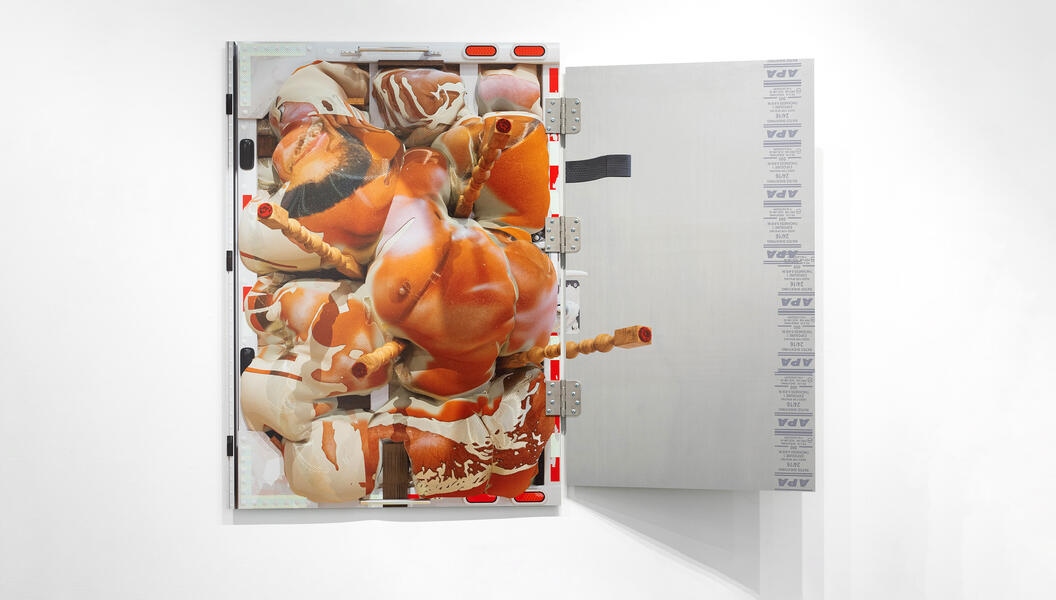 Oil on canvas web 3.jpg
Oil on canvas web 3.jpgAn erotic work printed on aluminum, takes its cue from the centerfold—a page at the heart of magazines where two adjoining pages form a single, often provocative image. This format, exploited by publishers, functioned as a kind of fold-out poster, a visual rupture in the otherwise linear narrative of print.
The piece presents a hyper-inflated image of a man's upper torso and head, framed awkwardly within the contours of a delivery truck. The image exceeds its boundaries, suggesting a visual tension between containment and excess. The textural qualities of the print and its style evoke both analog and digital aesthetics, referencing the halting, fragmentary loading of images via early dial-up connections, as well as the practice of repairing or extending a canvas by physically adding material.
This layered conversation recalls the story of Manet and Degas: in M. and Mme. Édouard Manet, Degas attempted to mend the canvas after Manet, dissatisfied with the depiction of his wife, slashed the painting. Such moments underscore the emotional volatility and material fragility embedded in the history of image-making.
-
 Cuckold Brood Series: Caught Up, ZOO
Cuckold Brood Series: Caught Up, ZOOHumiliation, male erotic exaggeration, embodied violence, female exaggeration, Cuckold as accessory to establish a relationship, engaging in something you have not created were starting points for this project.
UV print on mirror with accessories
102 x 136 inches
Katzen Arts Center at American University, Washington, DC
-
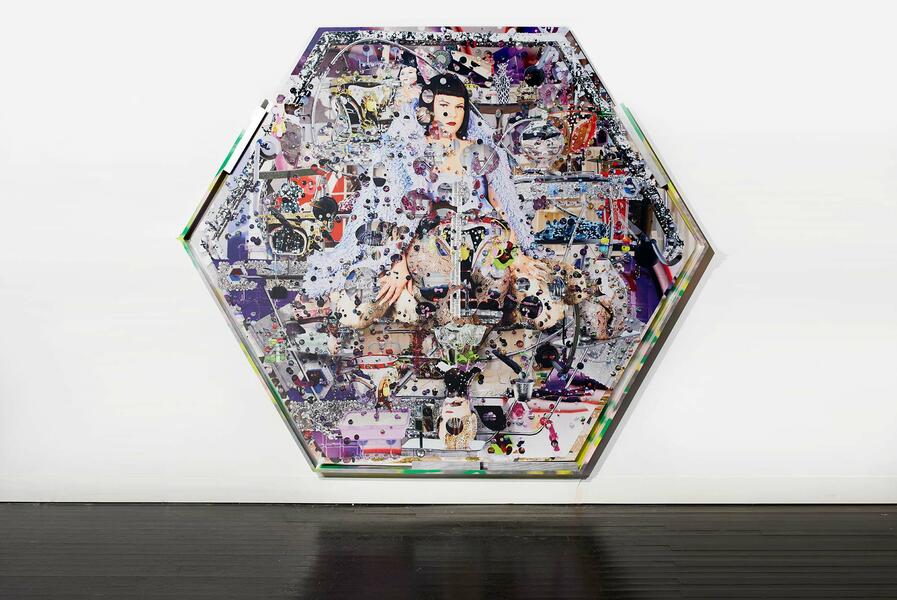 wickerham-lomax-domestic-qt-00034b.jpg
wickerham-lomax-domestic-qt-00034b.jpgHome was the location we initially identified as the container to explore what we've decided were five areas of interest: invasion, image problems, imaging home, access, and living with fictions. What is our identity if our new frontier was the home or cage as it was beginning to seem like.
Both the occupants and the space are a thing when in sync manifest a certain reality, but out of sync appear deeply emblematic of dysfunction. That was a tension we were trying to get at
Dye sublimation on canvas, wood, hardware, beads, artist frame.
106 x 99 x 3¾ in.
Modern Art Museum of Fort Worth, Fort Worth, TX
About Wickerham

Wickerham & Lomax is the collaborative name of Baltimore-based artists Daniel Wickerham (b. 1986, Columbus, OH) and Malcolm Lomax (b. 1986, Abbeville, SC). Their practice begins with codes—private symbolisms, gossip, inside jokes, and the low-stakes chatter that organizes real social life. They treat this accelerated exchange of “frivolous” information as material: something worth formalizing, staging, and giving dignity.
Our… more
Soft Gym
It replaces the view of a park with the act of moving through one: touching, leaning, resting, sweating. Between a grandmother's reminder to never forget where you come from and a mother's call to reinvent yourself, the work finds its rhythm in that tension-what's inherited stretching toward what's made.
The gym became a gem through pressure-of planning, of corre-spondence, of care-where softness works as both method and mood, keeping form open yet durable.
Its padded walls and gym rigs translate private gestures into public form; they remember contact the way the body remembers use.
The work translates the physical into the visual, pairing Baltimore's vernacular inventiveness with art-historical echoes-from tondos of Madonna and Child to Richard Serra's 'Tilted Arc.'
Here, feeling behaves. Manners count as a kind of muscle. Vulnerability holds civic weight. The park rehearses proximity: between image and touch, between bodies and generations, between seeing and being seen. To make form feel, the perfect rehearsal never ends.
American Pest & The Return of American Pest
2025 / Current Space, Baltimore, MD
FADE IN:
INT. PEST CONTROL CALL CENTER – NIGHTA low-lit, humming call center. Phones ring intermittently. One line clicks open.
OPERATOR
Pest Control, how can I help you?
CALLER
Um… hi. I’m not even sure if this is the right place to call.
Something’s happening—I saw it last year, in Miami,
but now it’s… here. In Baltimore.
OPERATOR
Can you describe the situation?
CALLER
I don’t know. It’s not a pest, exactly. Not like… rats or insects.
It’s more like—something in the air? A kind of atmosphere.
It’s thick, it’s everywhere, and it feels… full.
There are objects—hundreds, like, over 400—and they’re just… there. Watching. Waiting. Reacting?
OPERATOR
What do these objects look like?
CALLER
It’s hard to say. Some look like avatars.
Others like, I don’t know—tributes? Glitches?
There’s something emotional about them.
Like they’re carrying things—memories, missed connections, things you meant to say but didn’t.
It’s unsettling, but not…bad. Just… overwhelming?
OPERATOR
Is it causing any harm?
CALLER
No, not harm exactly. It’s more like…the space is breathing. Like it’s alive.
And it’s listening. Reacting to everything that’s been happening—like the election, the silence after, all the… disconnection. It’s not something you can remove.
I don’t even think it wants to leave.
OPERATOR
So, what would you like us to do?
CALLER
I’m not sure. I guess—I just needed to say it out loud.
That it’s here. That something is happening.
And it’s not going away.
A pause. Faint ambient sound in the background.
OPERATOR
Understood.
\[Call ends.\]
FADE OUT.
American Pest’ is the duo’s first solo exhibition in the wake of a global pandemic that forever altered the worlds that we inhabit. It is the duo’s most extravagant, excessive, and abundant presentation of new work yet. It is also the pair’s most abstract exhibition; the process and the making will take their final form in the gallery in the installation, with the viewer, the atmosphere comprising ‘American Pest.’
‘American Pest’ features over 400 new works by the collaborative duo that has been making art for over a decade. Embedded in their practice, it’s crux is connection – and the space of possibility in dislocation, reconnection, reconvening, recalibration, and regeneration.
Over 400 objects, aesthetic pests, and aberrations, 400 representations of the self, 400 representations of the soul, 400 longings, 400 yearnings, 400 missed calls, 400 deleted text messages, 400 tears, 400 reflections, 400 exclamation points, 400 wishes, 400 cigarettes butts, 400 drawings, 400 spaces for you to pause and reflect and understand that as long as you have breathe you can keep going, 400 tributes, 400 glitches, 400 cash app requests, 400 marks made by two artists who are translating the divine for the domestic audience.
-
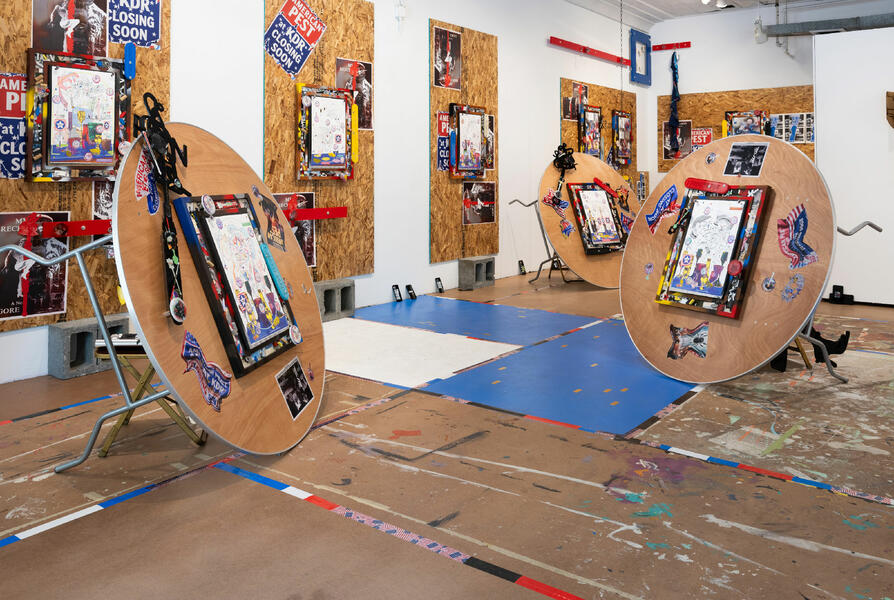 The Return of American Pest
The Return of American Pest -
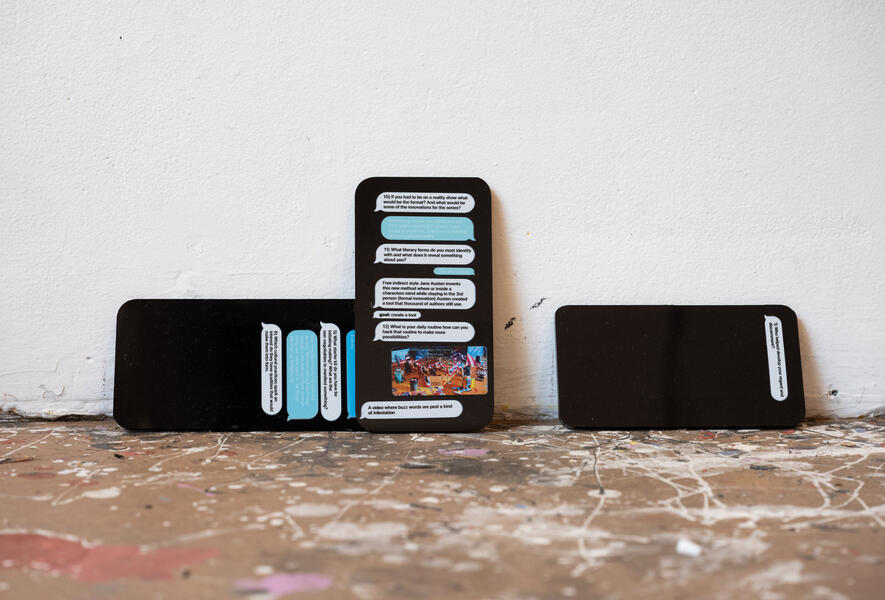 CurrentSpace_Wickerham&Lomax_06.12.25_web-43.jpg
CurrentSpace_Wickerham&Lomax_06.12.25_web-43.jpg -
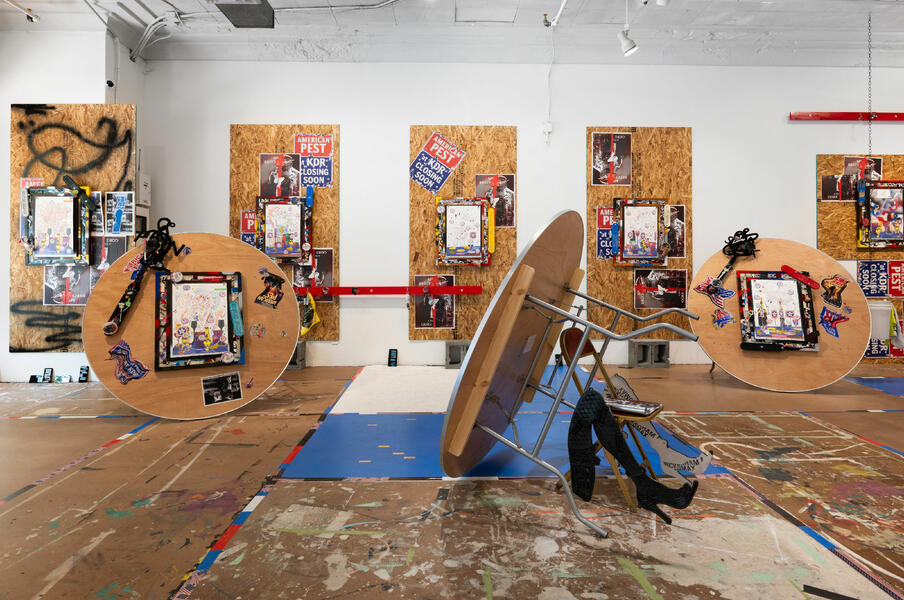 The Return of American Pest
The Return of American Pest -
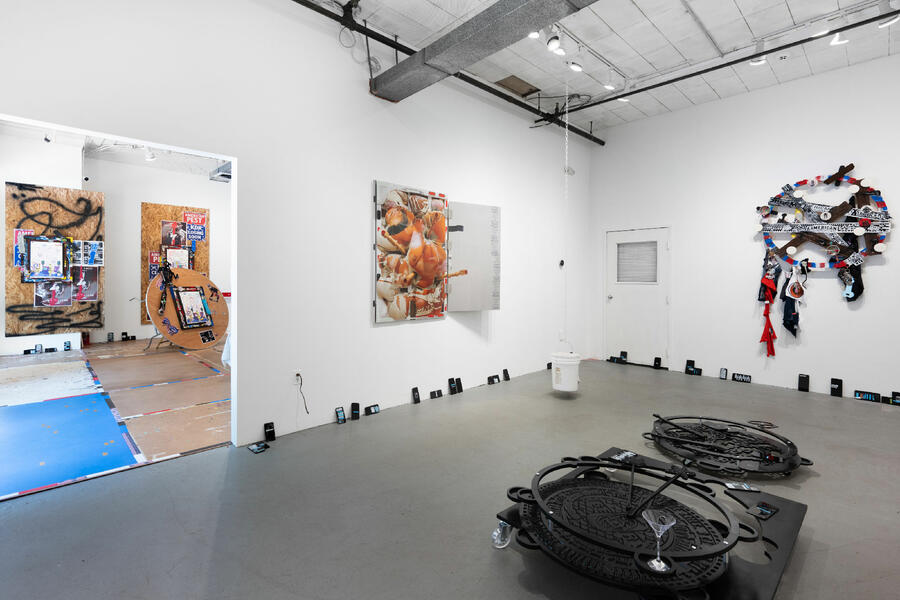 The Return of American Pest
The Return of American Pest -
 American Pest
American Pest -
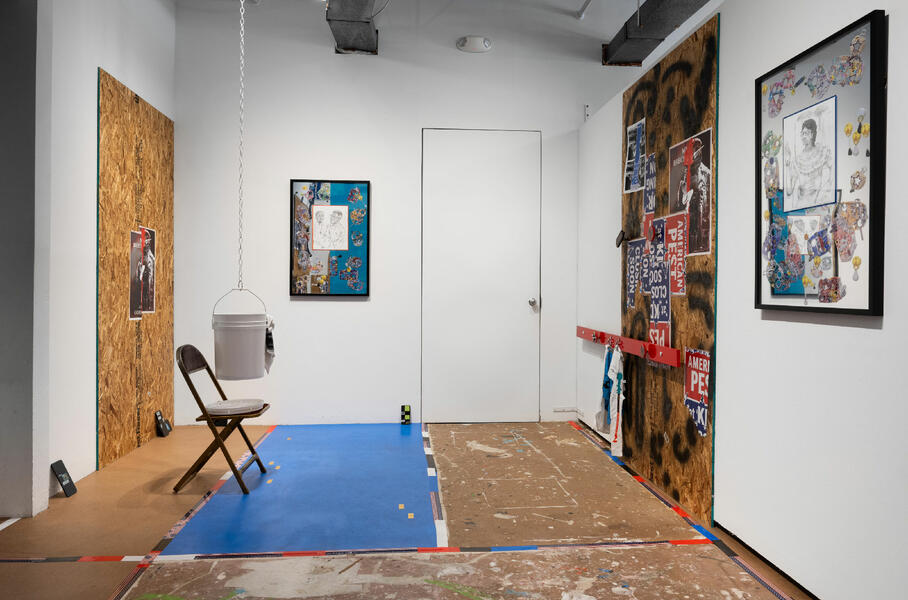 The Return of American Pest
The Return of American Pest -
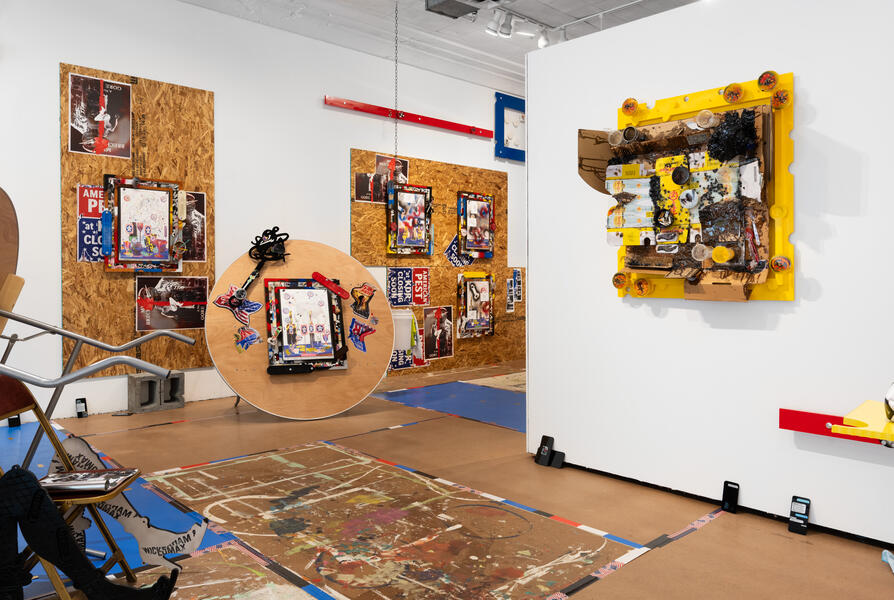 CurrentSpace_Wickerham&Lomax_06.12.25_web-14.jpg
CurrentSpace_Wickerham&Lomax_06.12.25_web-14.jpg -
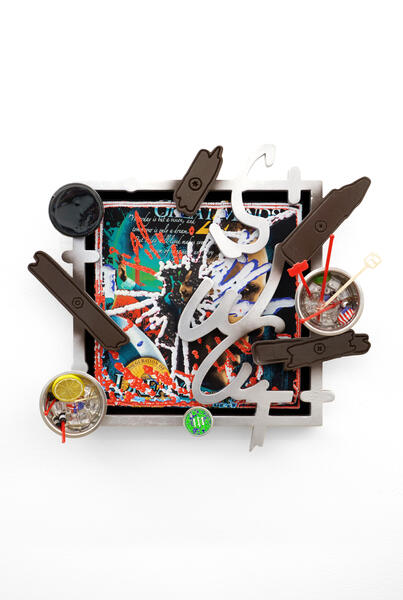 The American Dream
The American Dreamcotton t-shirt, DTF heat transfers, wood, velvet, aluminum, tinted resin on metal hardware, sobriety coin
16¾ x 16¾ x 7 in.
42.55 x 42.55 x 17.78 cm
-
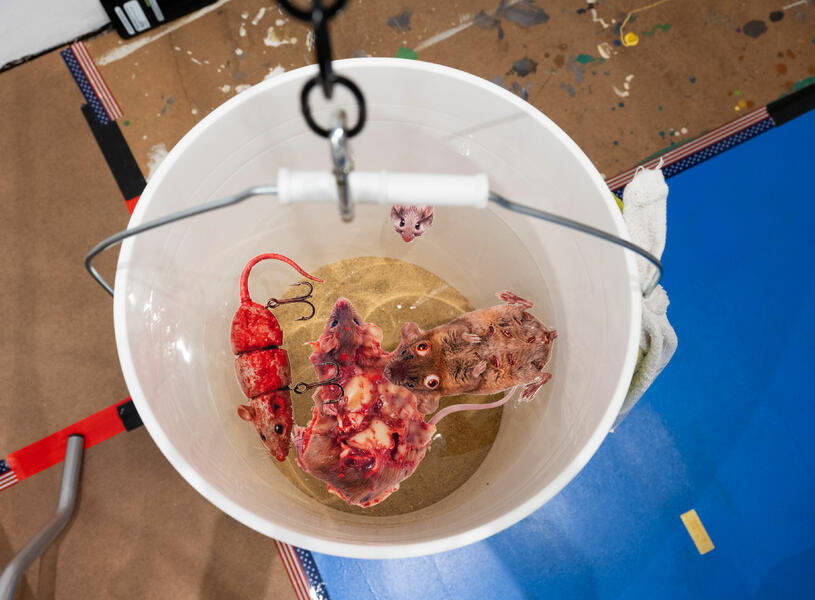 Trap
Trap -
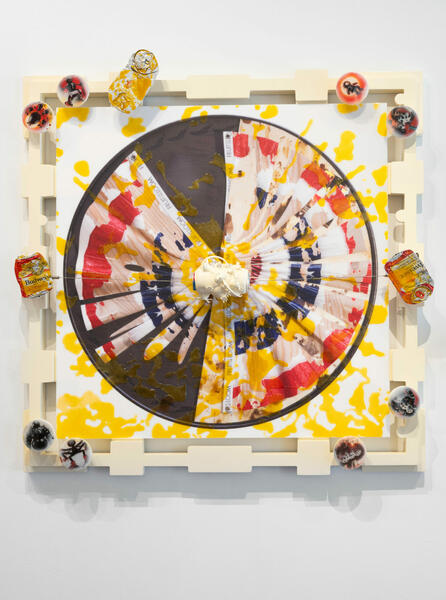 Sticky Trap (Red Bull)
Sticky Trap (Red Bull)Dye sublimation print on white acrylic, aluminum can, 3D print, wire, tinted resin on metal hardware, wood
45 x 45 x 4½ in.
Domestic QT + The Spatial Anamolies
The exhibition consist of over a dozen large-scale works, including seven printed acrylic panels suspended within rakish, jungle-gym-like metal scaffolds. Printed on both sides and riddled with cutaway shapes, these new works resemble holiday advent calendars whose visual lexis depicts a hallucinatory, non-Newtonian home interior wherein family pets and furniture trade appendages and the dialectics of the household—intimate vs. public, guileless vs. dirty, protected vs. exposed—invert themselves freely like deep sea creatures. A new series of paintings surround these assemblages, which will further attempt to contain the duo’s QT (quarantine) fugue state—with the picture plane full of extrusions, attachments, plug-ins and portals, as if in the middle of a machinic transformation or a system-wide breakdown.
-
Domestic QT Walkthrough
What this work is about: Gossip, distancing, surface, framing, supplementals, cultural practices, scripting, networked processes, provisionality, worldbuilding, transmedia storytelling, community, ensembles, friendships, strategies, faux-juvenility, and seduction.
-
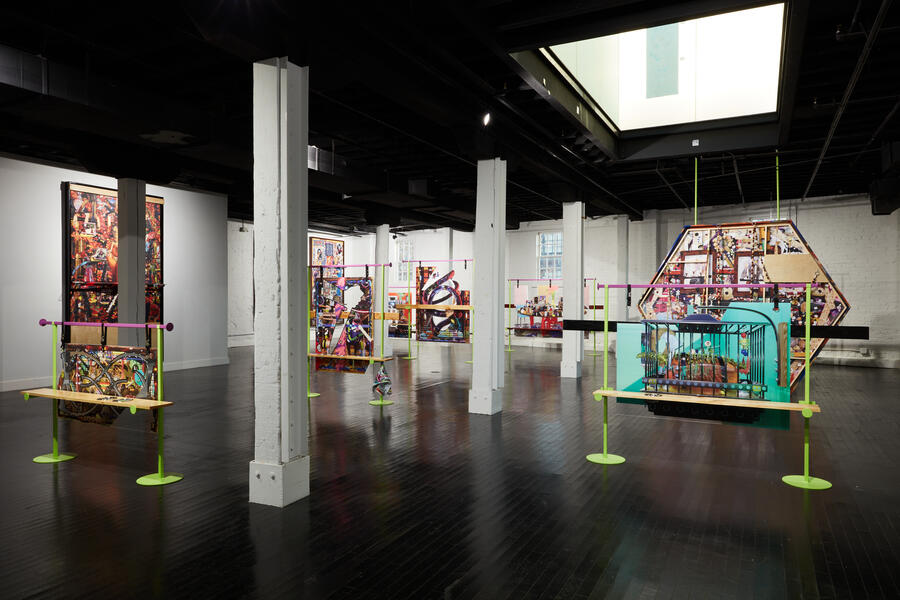 Domestic QT + The Spatial Anomalies
Domestic QT + The Spatial Anomalies -
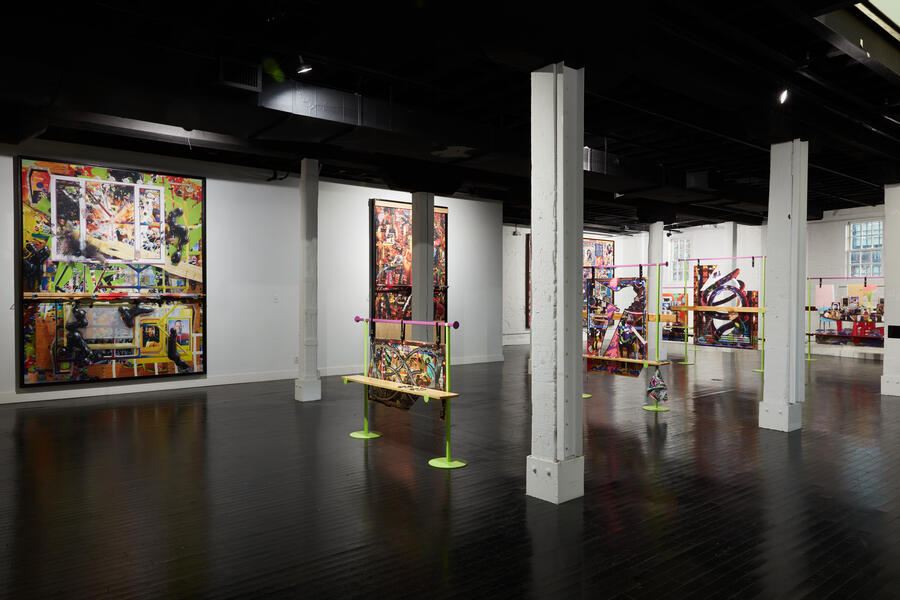 Domestic QT + The Spatial Anomalies
Domestic QT + The Spatial Anomalies -
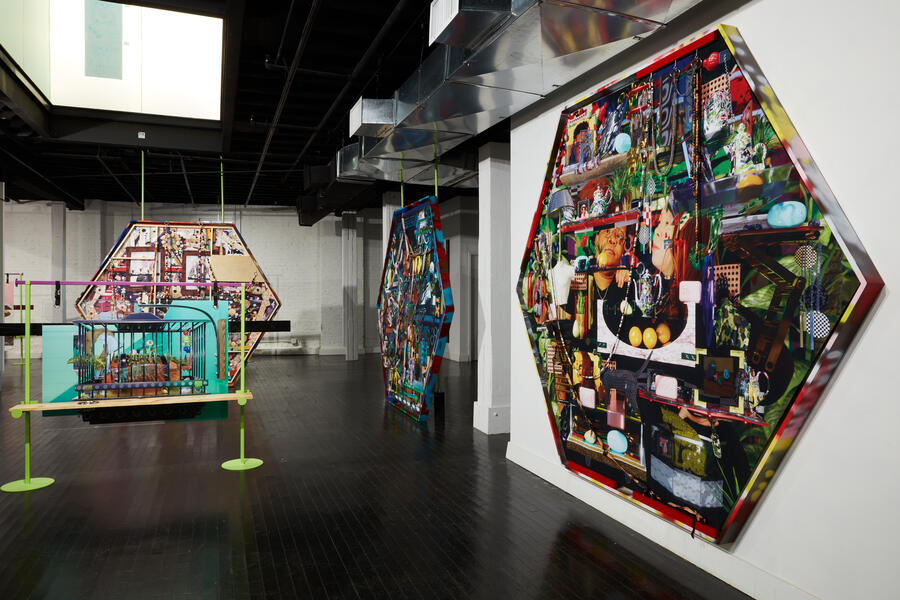 Domestic QT + The Spatial Anomalies
Domestic QT + The Spatial Anomalies -
 David Burns.jpg
David Burns.jpgPrinted on Plexiglass we consider the PNG as a kind of sculptural image having contained it in a second set of information known as an alpha channel and in the object we try to acknowledge that reality. It is an acknowledgement of transparency.
One of the great inventions has been these negative spaces, non printed areas on Plexiglas. We've developed this approach that first appeared in the Odell's exhibition.
Available for Purchase -
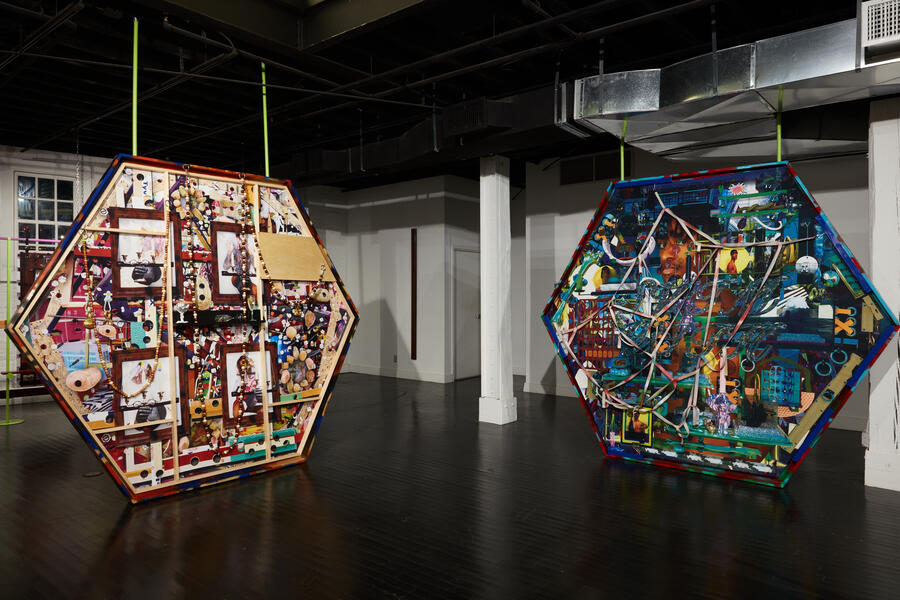 Installation view
Installation viewLeft to Right
Rebecca Lord, 2020
Dye sublimation on canvas, wood, hardware, beads, artist frame, foil, glass, epoxy, presentation fruit
106 x 99 x 6⅜ in.
269.2 x 251.5 x 16.2 cm
Nymph and the Net, 2020
Dye sublimation on canvas, wood, hardware, beads, artist frame
106 x 99 x 3¾ in.
269.2 x 251.5 x 9.5 cm
-
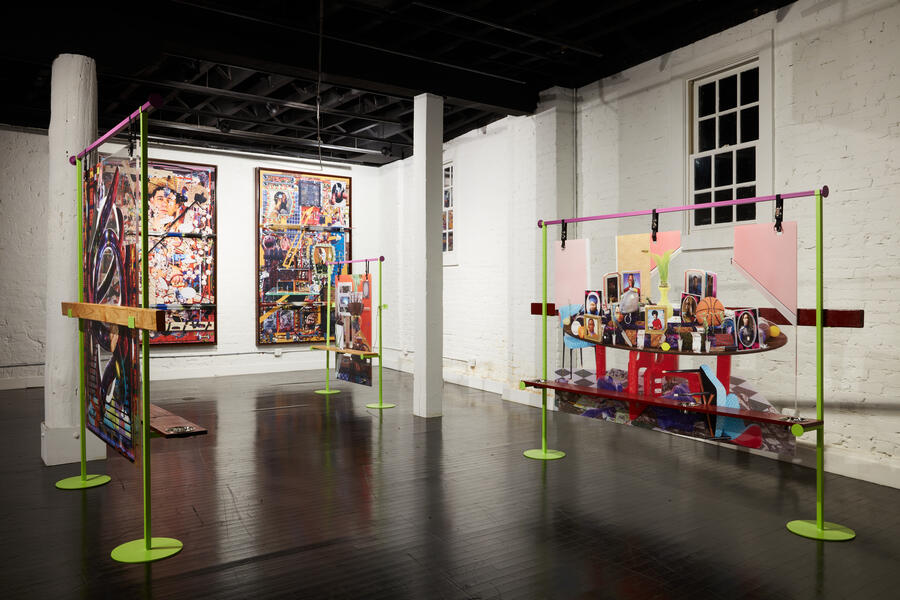 Domestic QT + The Spatial Anomalies
Domestic QT + The Spatial AnomaliesI think what these cutouts open the work up to being about literal voyeurism, shifting notions of public and private, ideas about physical closeness and new psychological relationships with space in the content of home.
Access as a foundational idea for the show in terms of density of visual language, keeping the viewer out and keeping them in by slowing down looking.
-
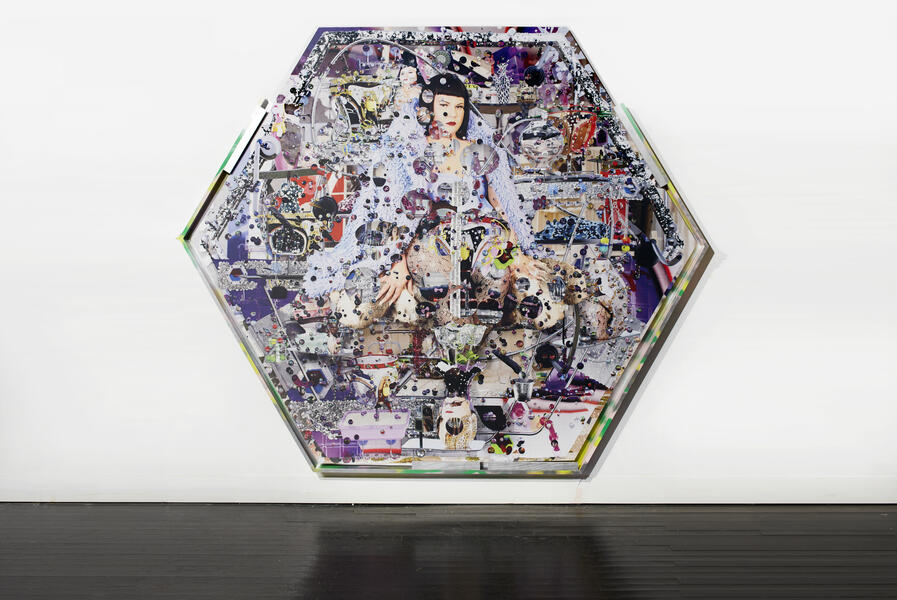 Lindsay Brien, 2020
Lindsay Brien, 2020Dye sublimation on canvas, wood, hardware, beads, artist frame
106 x 97 x 3¾ in.
269.2 x 246.4 x 9.5 cm
We definitely wanted the language of Things in the work. The language of display and artifact and artifice has always been an interest. It seems both a celebration of things and a fantastic display of beautiful things and also a critique of them. It's a mixture of the objects from the owner of the house and some standard objects the artist added in. I like this relationship to the Still Life genre: A candle, A clock, A vase. That's the language of home.
-
 Screen Shot 2024-01-13 at 11.19.41 AM.png
Screen Shot 2024-01-13 at 11.19.41 AM.pngVampire was this metaphor for access to people's lives online and for inviting in ideas for the show. What would we let into the house?
Points of departure: vampire invitation, pet adoption, interior design, gay cohabitation, ambiguous boundaries, hauntings, sex lives, floral arrangements, the movers, zoo enclosures,
Monogamy, non-monogamy, pest, ghost stories, survival, anachronism, memories, anniversaries,
Hostel environments and cooking
-
Domestic QT Trailer
Cultures Panic Room
Culture’s Panic Room is an immersive and mesmerizing exhibition by the emerging American artist duo Wickerham & Lomax. Coinciding with Frieze London, the site-specific installation will welcome visitors from 14th-28th October and marks the pair’s debut exhibition in the UK, while offering an all-new experience at The London EDITION.
Situated in the hotel’s BASEMENT, which was originally conceived as a nightclub, the mixed-media installation playfully meditates upon questions regarding luxury, presence, individuation, and access. The artists will transform the space into a highly reflective and sensory experience imitating a panic room with CGI mapped characters as tropes surrounding: the heist, the encounter, the intruder and the stranger as subjects of imagined realities. Through interaction with the digitally rendered CGI characters and other exhibition visitors, the installation encourages its audience to reconsider its relationship with self and others in space.
The bold club culture sensibilities of the artists are married with the nocturnal nightclub aesthetic of the exhibition space as the exhibition blurs the boundaries between the real world and virtual through neon lights, plexiglass and acrylic sculptures and digitally mapped CGI characters. Their gallerist, Todd von Ammon, is printed in the round on a charity tank – while digitally augmented he lounges, eagerly waiting to be showered by visitors’ donations with proceeds going to Ballet After Dark, an organization based in Baltimore, MD, that assists sexual trauma survivors with their recovery through dance.
Hotly tipped as ‘Ones to Watch’ by Artforum in 2020, Wickerham & Lomax’s large scale installations employ queer sensibilities, speculative fictions and networked virtuality to explore subculture, marginality and connectivity as a way to complicate mainstream perspectives. The London EDITION’s sleek architecture and tasteful decor provide an exquisite backdrop for presenting the artists’ work in a dynamic way while offering a portal into the essence of the city.
QT Bags for Maison Margiela
THE DENSELY PACKED COMPOSITIONS of collaborative duo Daniel Wickerham and Malcolm Lomax pulsate with a formal and referential dynamism that binds the work’s mess of elements into something far greater than the sum of its myriad parts. Though initially dizzying to behold, a harmonizing consonance quells the apparent chaos, allowing networks of sensory and cognitive associations to coalesce and cohere. To further assist navigation through their built-up material and pictorial environments, the artists often provide textual road maps. For their recent show at Von Ammon Co. in Washington, DC, titled “Domestic QT and the Spatial Anomalies,” the pair supplied an alphabetically organized glossary of ideas informing the exhibition’s development. Dilating skeptically on no fewer than fifty concepts and phenomena pertaining mostly to home quarantine, popular culture, and sociality, the document served to clarify and enrich the viewer’s apprehension of the works’ corralling of swarming signifiers, while preserving sufficient ambiguity to facilitate poetic communion. Broad-ranging, idiosyncratic, and incisive, these texts demonstrate an active intelligence that dissects and analyzes everything in its path.
For this project, Wickerham & Lomax have taken their thematic cues, for the most part, from Ursula K. Le Guin’s “The Carrier Bag Theory of Fiction,” a short essay critiquing the thrust and parry of heroic narrativity, touting the tote, as opposed to weaponry, as the most significant human—and, metaphorically, literary—invention. Picking up where the DC show left off, each of the following pages explores different aspects of domestic containment, though in this instance conflated, per Le Guin, with visual musings on that most intimate and thereby self-defining of receptacles, the handbag. And because too much is never enough when it comes to maximal aggregation, these images also allude to a variety of household appliances—the vacuum cleaner, the washing machine, the freezer, the stove—while additionally calling attention to a series of gay-bar closures and generational renovations (name-checked by the titles) in Baltimore, where the artists reside. To say these pictures are loaded is a grand understatement; meaning and affect churn and proliferate within them. Created via the aptly named 3D-modeling software Blender, Wickerham & Lomax’s flawless synthetic concoctions shred, queer, and reconstitute heteronormativity as critically charged fields of multivalent intensity.
“Margiela’s ideas have influenced our work since the very beginning back in 2009 when we started working together. We structured a whole show at Artist Space around three jackets Margiela made in 2008. His consideration of modes of representation and questioning the reality of a garment have always interested us,” said Wickerham & Lomax. “For the work hanging at 1 Crosby, we added to the chaos by making digital images of domestic appliances turned into gay purses and printed on mirrored acrylic. What we’re calling ‘Quarantine Bags’ are each 4 by 4 feet set in a digital dig site that evoke our favorite gay bars now closed due to the pandemic. All four works are framed in estate sale jewelry in a moat of epoxy with lots of silver gold leaf. Come see them at noon and the sun hits them at the perfect blinding angle all authorship disappears.”
-
 Artform feature
Artform feature -
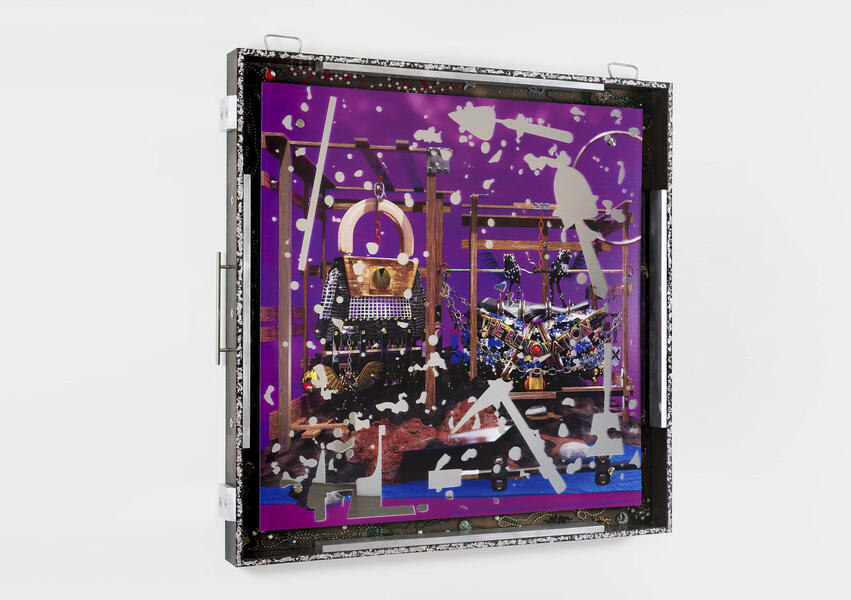 The Migration 7.25/8.11 Bag
The Migration 7.25/8.11 BagFlatbed direct print on mirrored acrylic with polished edge, zinc hardware, vintage jewelry, resin, silver leaf artist frame
60 x 60 inches
152.4 x 152.4 cm
-
 Installation view
Installation view -
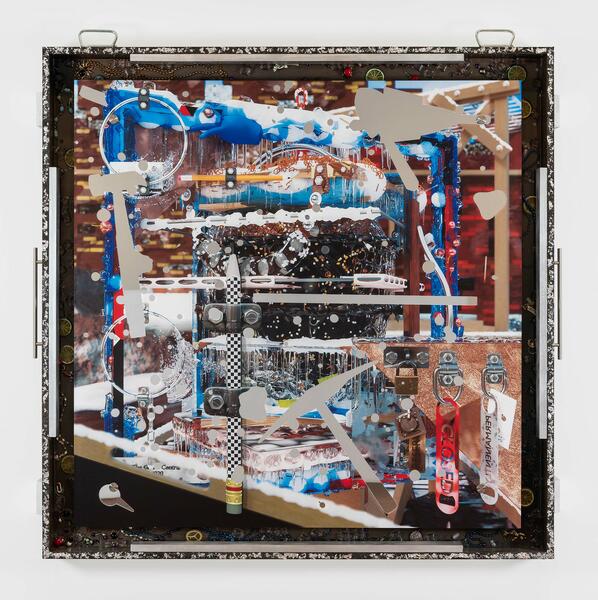 The G. Central 7.30 Freezer Bag
The G. Central 7.30 Freezer BagFlatbed direct print on mirrored acrylic with polished edge, zinc hardware, vintage jewelry, resin, silver leaf artist frame
60 x 60 inches
152.4 x 152.4 cm
-
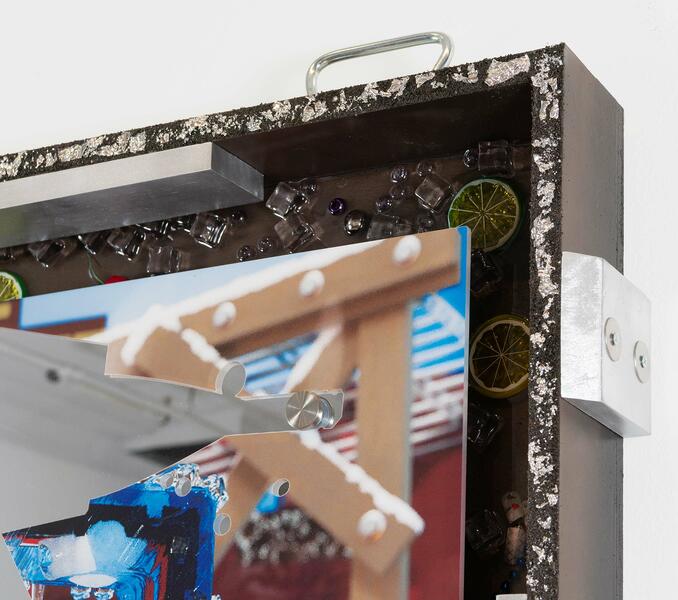 Detail, The G. Central 7.30 Freezer Bag
Detail, The G. Central 7.30 Freezer Bag -
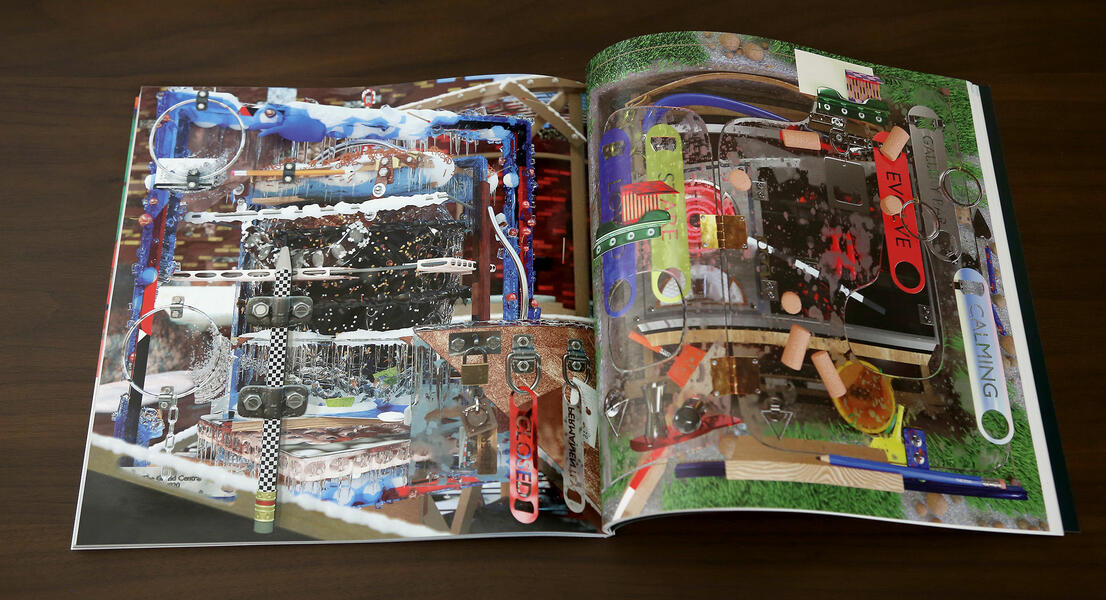 Artform feature
Artform feature -
 The Hippo 10.8 Vacuum Bag
The Hippo 10.8 Vacuum BagFlatbed direct print on mirrored acrylic with polished edge, zinc hardware, vintage jewelry, resin, silver leaf artist frame
60 x 60 inches
152.4 x 152.4 cm
-
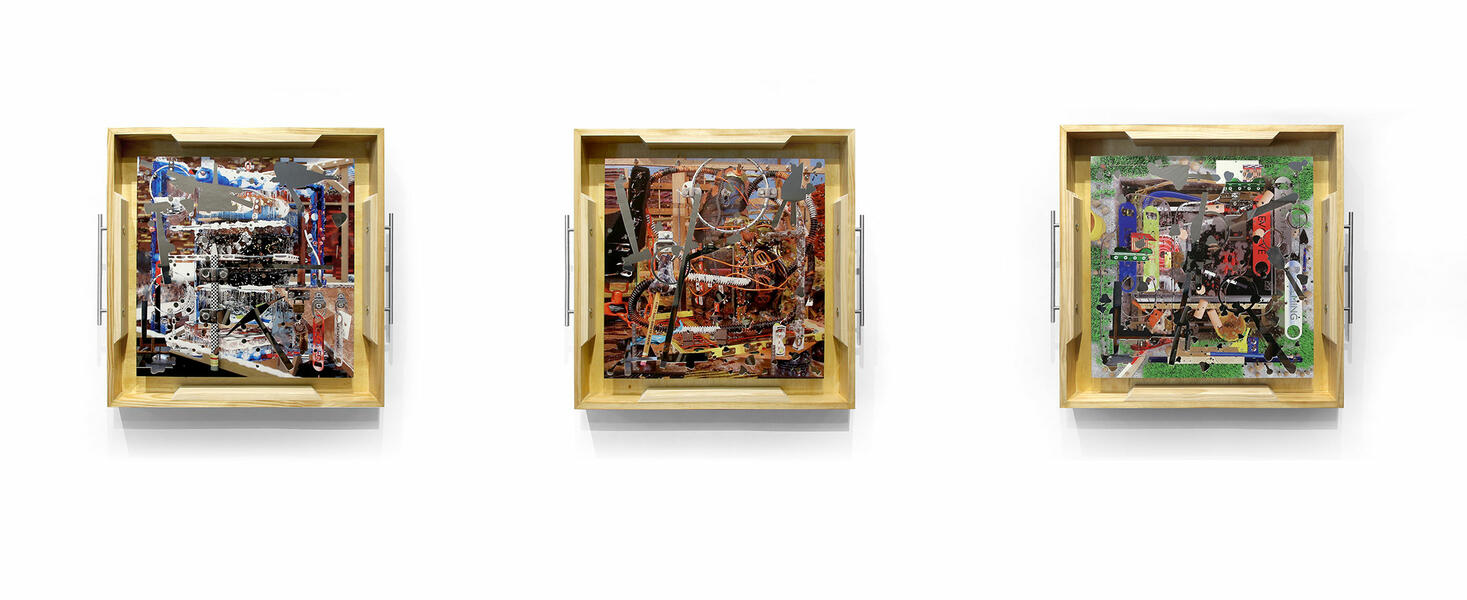 Covid Bags Tiny
Covid Bags TinyFlatbed direct print on mirrored acrylic with polished edge, zinc hardware, pine tray-frame
Dimensions
30 x 32 x 1 ½ in.
76.2 x 81.28 x 3.81 cm
-
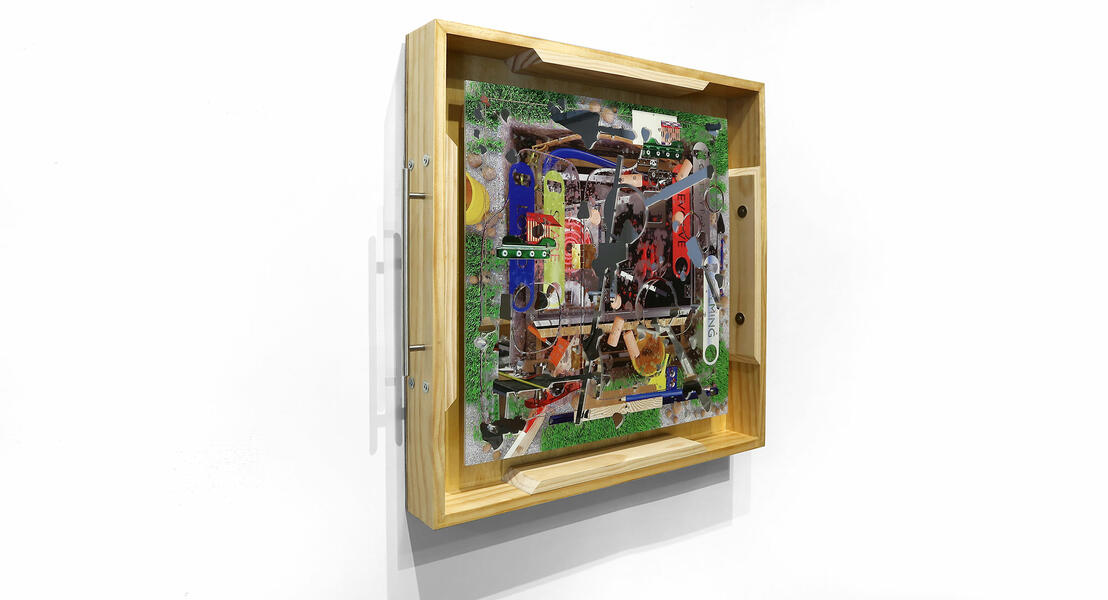 The Gallery Bar 6.6 Stove Bag
The Gallery Bar 6.6 Stove BagMedium Flatbed direct print on mirrored acrylic with polished edge, zinc hardware, pine tray-frame
Dimensions
30 x 32 x 1 ½ in.
76.2 x 81.28 x 3.81 cm
-
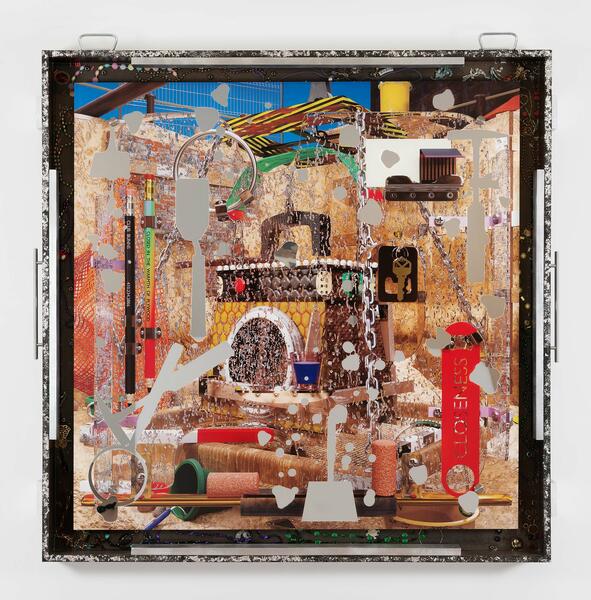 The Club Bunns 6.1 Laundry Bag
The Club Bunns 6.1 Laundry BagFlatbed direct print on mirrored acrylic with polished edge, zinc hardware, vintage jewelry, resin, silver leaf artist frame
60 x 60 inches
152.4 x 152.4 cm
Channel Heal: The Writer’s Room
July 12–August 1, 2018 / Reginald F. Lewis Museum / Baltimore, MD
Channel Heal: The Writer’s Room is a work intended to survey various metaphysical phenomena and explore their use as correctives to conflict and trauma. The phenomena engaged in this exhibition include: physicality (the physical attributes of a person); mysticality (relating to the spiritual or symbolic), egotism (excessive focus on the self), and transcendence (going beyond ordinary limits).
Wickerham & Lomax have transformed The Reginald F. Lewis lab space into a writer’s room, a stage, where themes will be discussed and collected as reference material for a future endeavor entitled Channel Heal – a video platform chronicling various Baltimore creatives in their transgressive acts – acts that may go beyond established limits or boundaries. On display are newly fabricated pieces that are aberrations of objects typically used by those in the film and television industry. Dry erase boards, clocks, and post-it notes are sample props of the televisual writer, and in this exhibition they crystallize or define moments that would either be provisional or serve to transform the thoughts, ideas, and gestures into an artwork.
The artists work in the space of complicating binary oppositions – virtual vs. real, individual vs. group, and narrative vs. nonsensical. In this exhibition the installation and subsequent programs work in tandem to present both platform and action as a way of externalizing thoughts on conflict and trauma. Ultimately they will be transitioned into form.
-
 Channel Heal: The Writer’s Room
Channel Heal: The Writer’s Room -
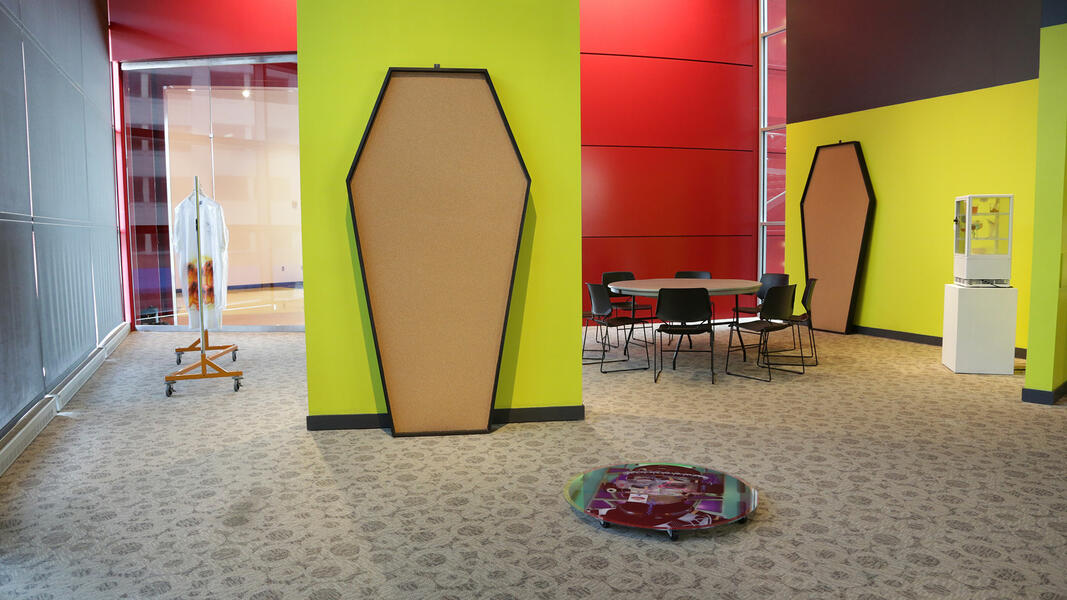 Channel Heal: The Writer’s Room
Channel Heal: The Writer’s Room -
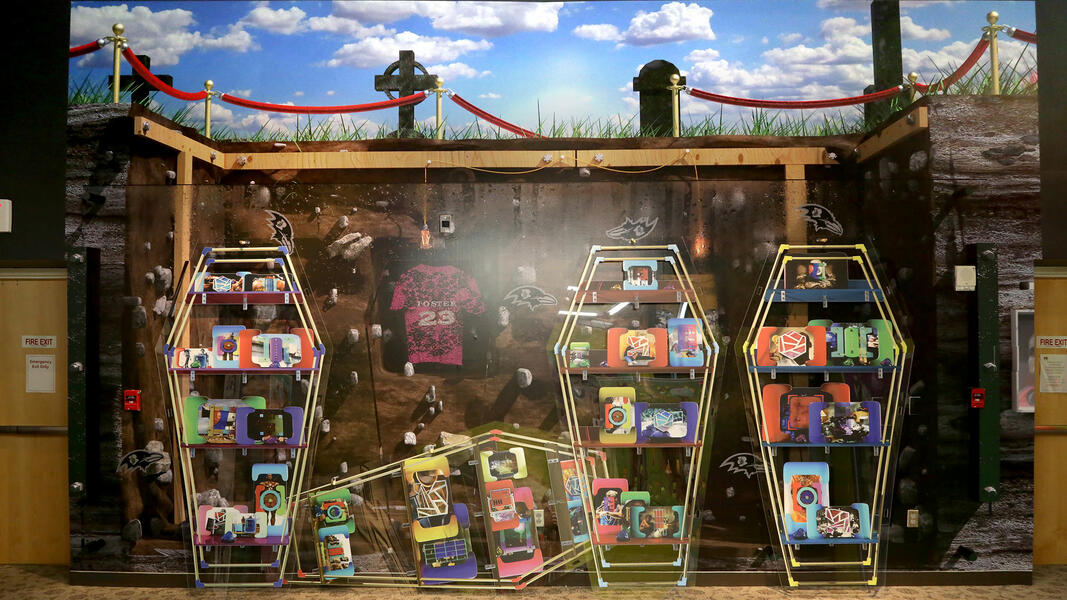 Channel Heal: The Writer’s Room
Channel Heal: The Writer’s Room -
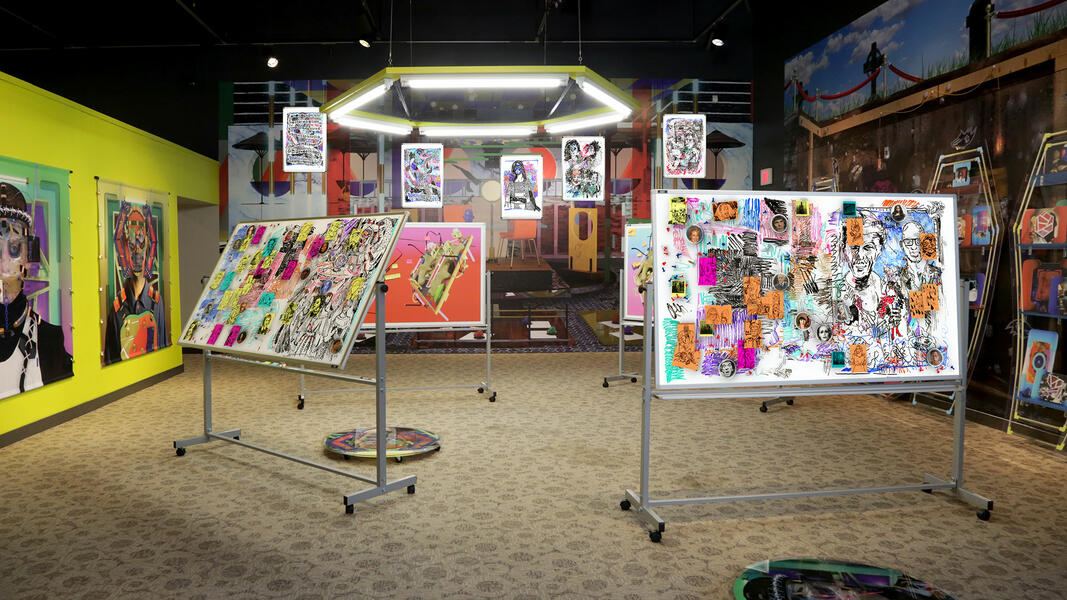 Channel Heal: The Writer’s Room
Channel Heal: The Writer’s Room -
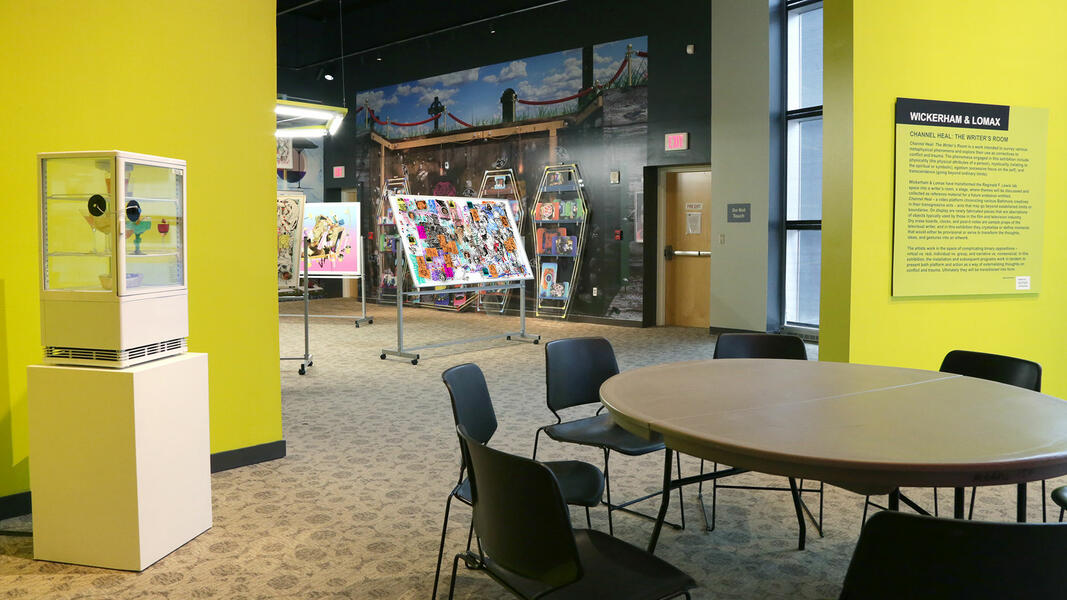 Channel Heal: The Writer’s Room
Channel Heal: The Writer’s Room -
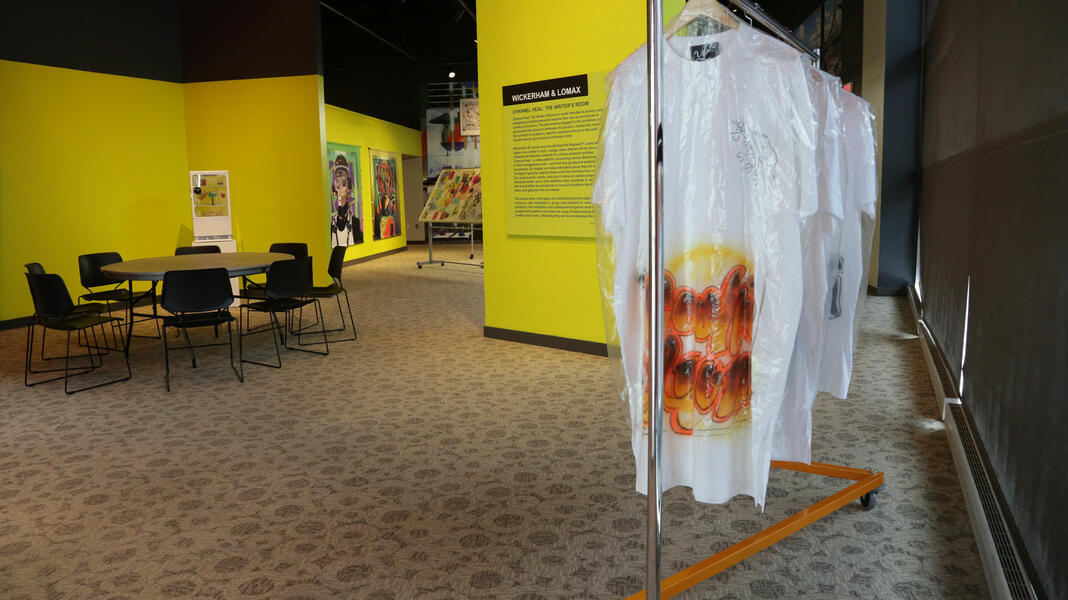 Channel Heal: The Writer’s Room
Channel Heal: The Writer’s Room -
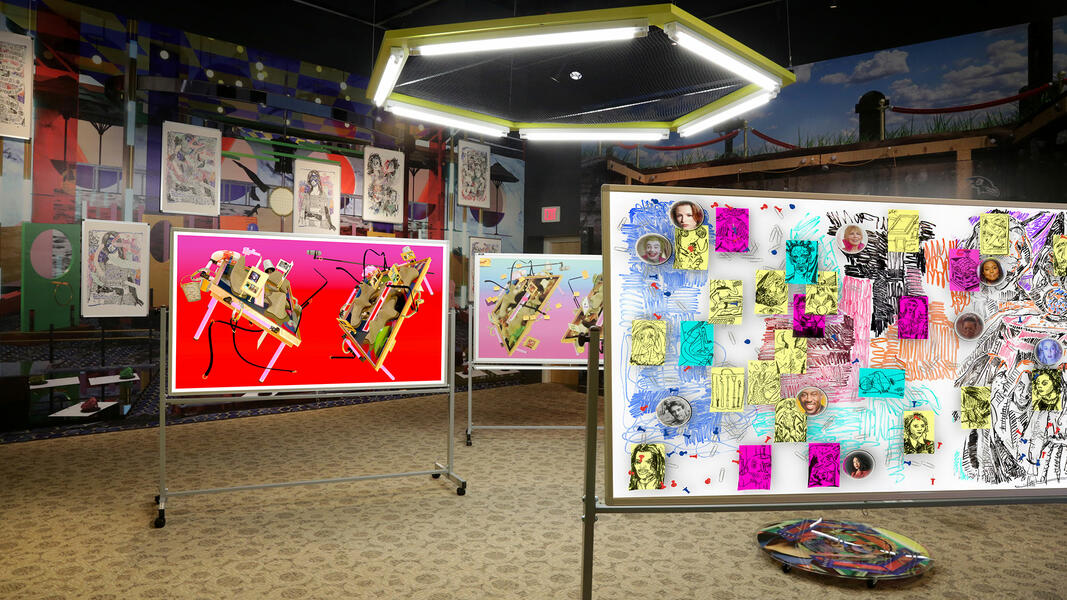 Channel Heal: The Writer’s Room
Channel Heal: The Writer’s Room -
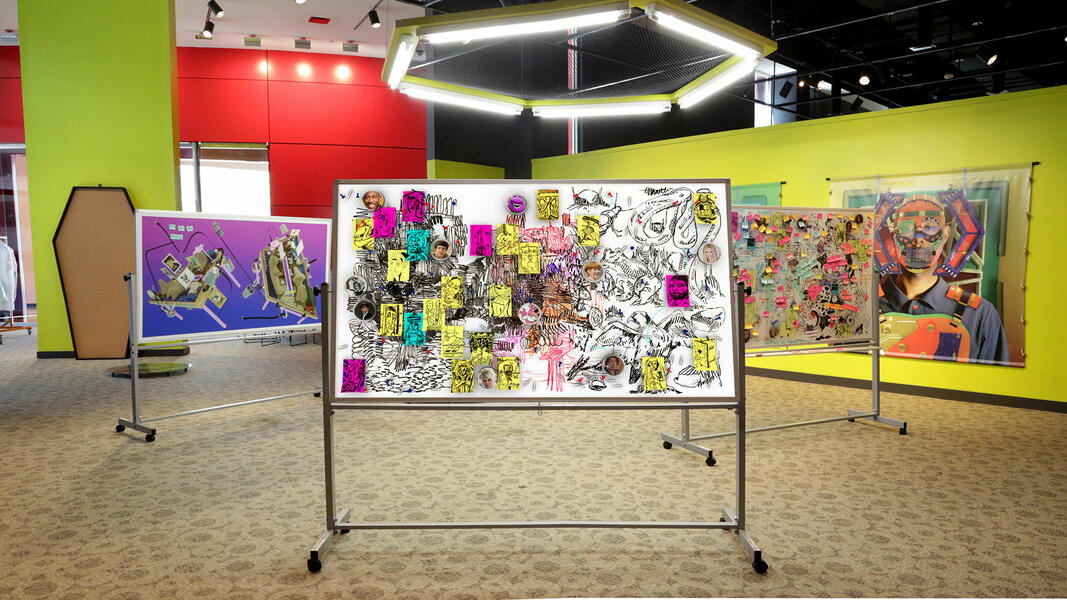 Channel Heal: The Writer’s Room
Channel Heal: The Writer’s Room -
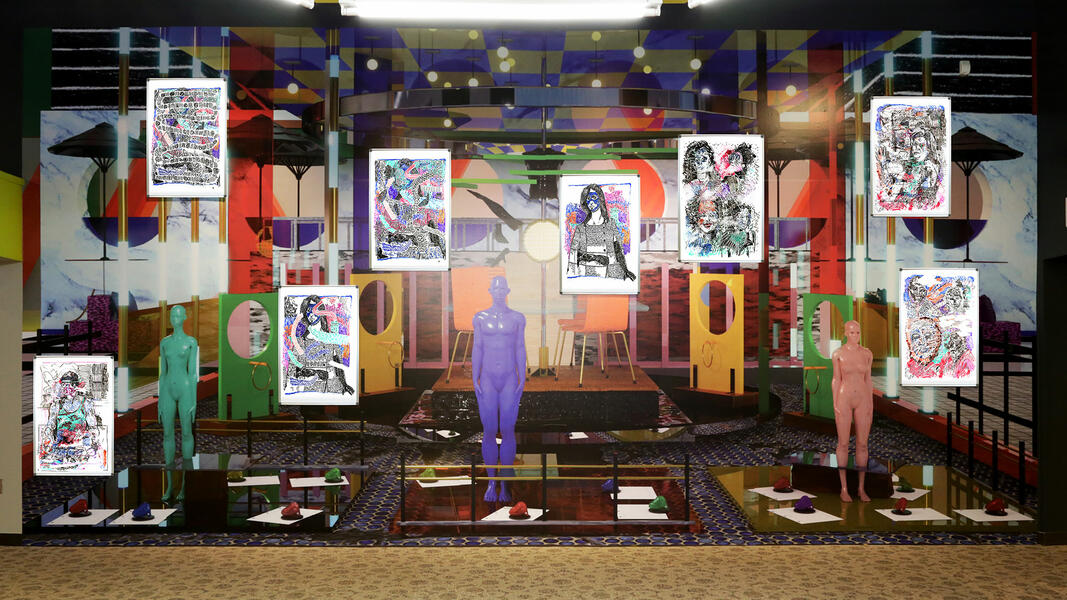 Channel Heal: The Writer’s Room
Channel Heal: The Writer’s Room -
 Channel Heal: The Writer’s Room
Channel Heal: The Writer’s Room
DUOX4Odells: You'll Know If You Belong
DUOX4Odells: You'll Know If You Belong, an ode to the legacy of Odell's, the legendary nightclub that still stands today as an aberration of its former self, no longer in use and still maintaining its peculiar facade on North Avenue. Through an installation spanning multiple projections, personal testimonies, and sculpture, Wickerham & Lomax investigate the rich history of the club's years of occupancy from 1976-1992, an attempt at preserving and illuminating its cultural memory in the Station North Arts & Entertainment District and contemporary Baltimore club culture. Recorded history is fused with the artist's imagination that brings the past into the present where its hardens into a meditation on loss.
-
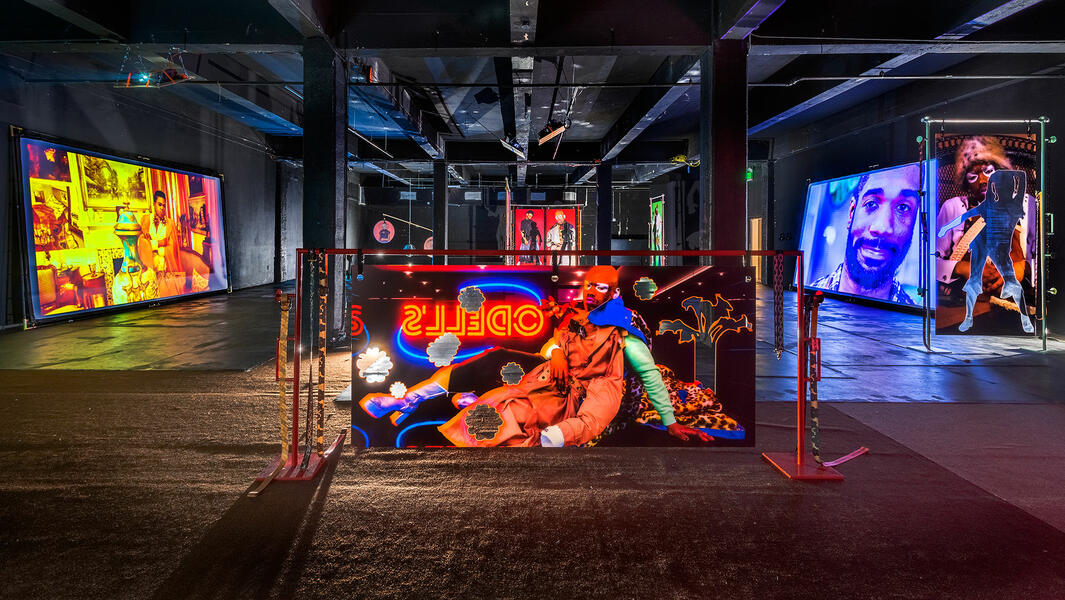 duox4odells-edit-neon.jpeg
duox4odells-edit-neon.jpegDUOX4Odell’s You’ll Know If You Belong, an ode to the legacy of Odell’s, the legendary nightclub that still stands today as an aberration of its former self, no longer in use and still maintaining its peculiar façade on North Avenue. Through an installation spanning multiple projections, personal testimonies, and free-standing sculpture, Wickerham & Lomax investigate the rich history of the club’s years of occupancy from 1976–1992, an attempt at preserving and illuminating its cultural memory in the Station North Arts & Entertainment District and contemporary Baltimore club culture.
-
 DUOX4Odells: You'll Know If You BelongDUOX4Odell’s You’ll Know If You Belong, an ode to the legacy of Odell’s, the legendary nightclub that still stands today as an aberration of its former self, no longer in use and still maintaining its peculiar façade on North Avenue. Through an installation spanning multiple projections, personal testimonies, and free-standing sculpture, Wickerham & Lomax investigate the rich history of the club’s years of occupancy from 1976–1992, an attempt at preserving and illuminating its cultural memory in the Station North Arts & Entertainment District and contemporary Baltimore club culture.
DUOX4Odells: You'll Know If You BelongDUOX4Odell’s You’ll Know If You Belong, an ode to the legacy of Odell’s, the legendary nightclub that still stands today as an aberration of its former self, no longer in use and still maintaining its peculiar façade on North Avenue. Through an installation spanning multiple projections, personal testimonies, and free-standing sculpture, Wickerham & Lomax investigate the rich history of the club’s years of occupancy from 1976–1992, an attempt at preserving and illuminating its cultural memory in the Station North Arts & Entertainment District and contemporary Baltimore club culture. -
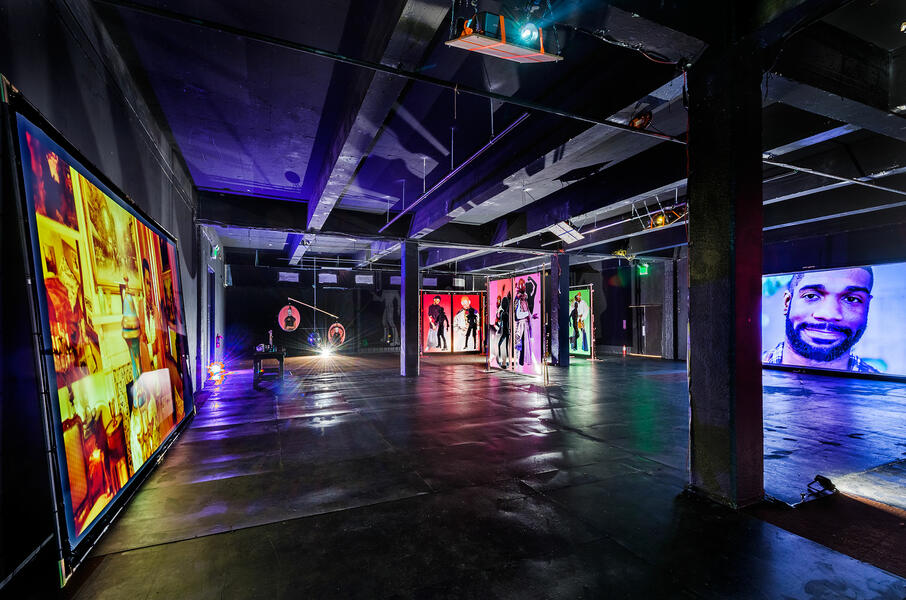 DUOX4Odells 3.jpegDUOX4Odell’s You’ll Know If You Belong, an ode to the legacy of Odell’s, the legendary nightclub that still stands today as an aberration of its former self, no longer in use and still maintaining its peculiar façade on North Avenue. Through an installation spanning multiple projections, personal testimonies, and free-standing sculpture, Wickerham & Lomax investigate the rich history of the club’s years of occupancy from 1976–1992, an attempt at preserving and illuminating its cultural memory in the Station North Arts & Entertainment District and contemporary Baltimore club culture.
DUOX4Odells 3.jpegDUOX4Odell’s You’ll Know If You Belong, an ode to the legacy of Odell’s, the legendary nightclub that still stands today as an aberration of its former self, no longer in use and still maintaining its peculiar façade on North Avenue. Through an installation spanning multiple projections, personal testimonies, and free-standing sculpture, Wickerham & Lomax investigate the rich history of the club’s years of occupancy from 1976–1992, an attempt at preserving and illuminating its cultural memory in the Station North Arts & Entertainment District and contemporary Baltimore club culture. -
 DUOX4Odells 6.jpeg
DUOX4Odells 6.jpeg -
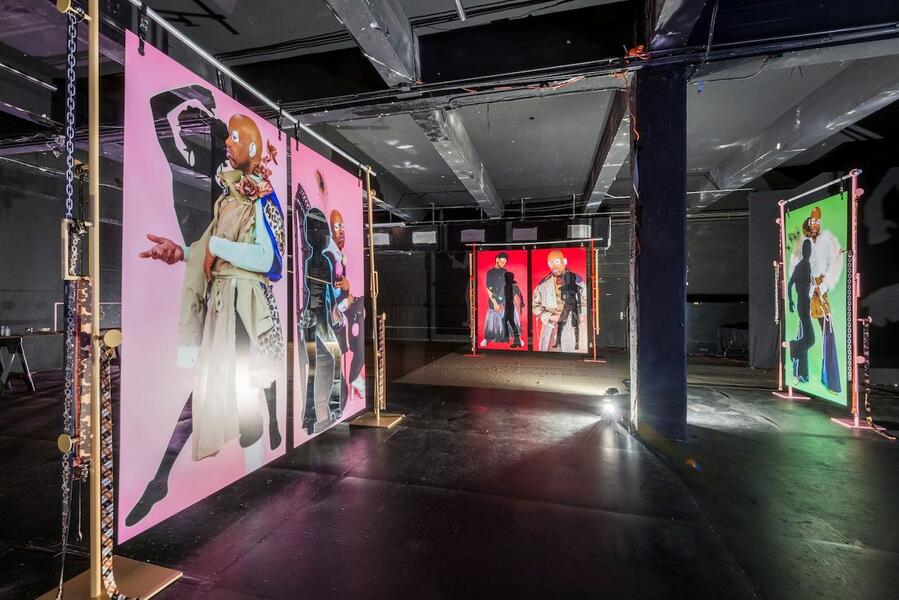 DUOX4Odells 4.jpeg
DUOX4Odells 4.jpeg -
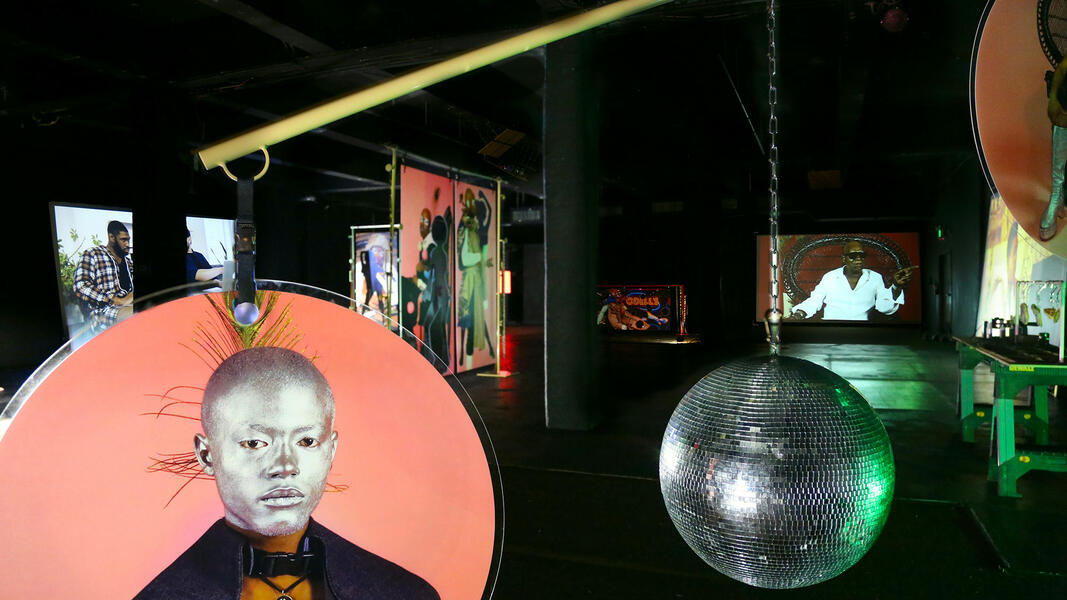 duox4odells-11.jpgDUOX4Odell’s You’ll Know If You Belong, an ode to the legacy of Odell’s, the legendary nightclub that still stands today as an aberration of its former self, no longer in use and still maintaining its peculiar façade on North Avenue. Through an installation spanning multiple projections, personal testimonies, and free-standing sculpture, Wickerham & Lomax investigate the rich history of the club’s years of occupancy from 1976–1992, an attempt at preserving and illuminating its cultural memory in the Station North Arts & Entertainment District and contemporary Baltimore club culture.
duox4odells-11.jpgDUOX4Odell’s You’ll Know If You Belong, an ode to the legacy of Odell’s, the legendary nightclub that still stands today as an aberration of its former self, no longer in use and still maintaining its peculiar façade on North Avenue. Through an installation spanning multiple projections, personal testimonies, and free-standing sculpture, Wickerham & Lomax investigate the rich history of the club’s years of occupancy from 1976–1992, an attempt at preserving and illuminating its cultural memory in the Station North Arts & Entertainment District and contemporary Baltimore club culture. -
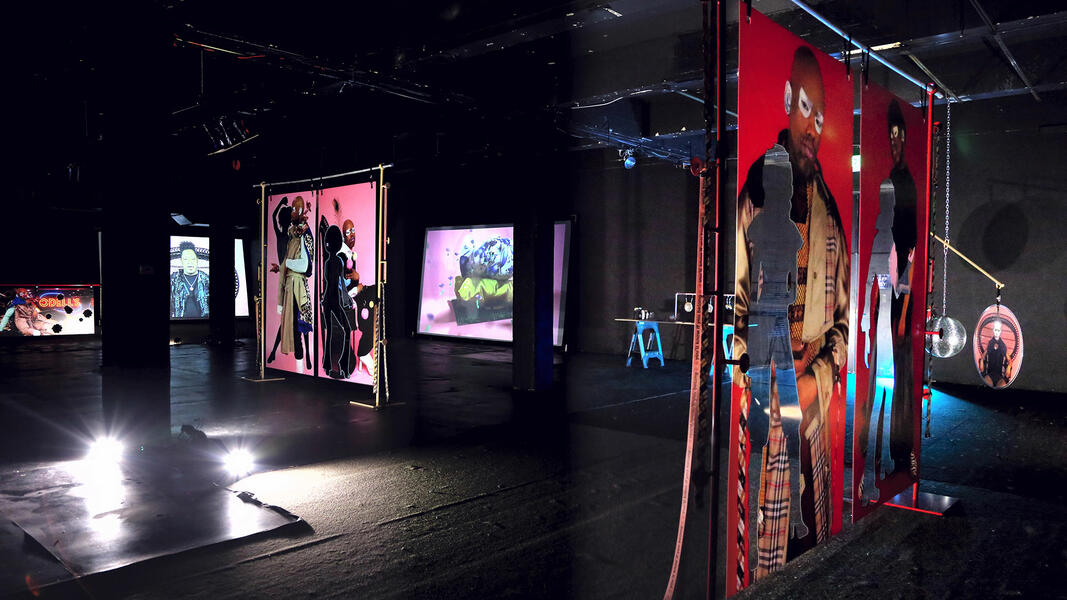 duox4odells-09.jpgDUOX4Odell’s You’ll Know If You Belong, an ode to the legacy of Odell’s, the legendary nightclub that still stands today as an aberration of its former self, no longer in use and still maintaining its peculiar façade on North Avenue. Through an installation spanning multiple projections, personal testimonies, and free-standing sculpture, Wickerham & Lomax investigate the rich history of the club’s years of occupancy from 1976–1992, an attempt at preserving and illuminating its cultural memory in the Station North Arts & Entertainment District and contemporary Baltimore club culture.
duox4odells-09.jpgDUOX4Odell’s You’ll Know If You Belong, an ode to the legacy of Odell’s, the legendary nightclub that still stands today as an aberration of its former self, no longer in use and still maintaining its peculiar façade on North Avenue. Through an installation spanning multiple projections, personal testimonies, and free-standing sculpture, Wickerham & Lomax investigate the rich history of the club’s years of occupancy from 1976–1992, an attempt at preserving and illuminating its cultural memory in the Station North Arts & Entertainment District and contemporary Baltimore club culture. -
Wormholes Odell's
-
Wormholes Antiques
-
Wormholes Allen and Robert
Local Atonement - A Nutshell Study of Unexplained Death
American Medium is proud to presentLocal Atonement: A Nutshell Study of Unexplained Death, Wickerham & Lomax’s first solo show in New York in four years. The exhibition will trace some of the key themes in their 2012 Artists Space show DUOX4Larkin, which concerned the workspace as an articulation of one’s identity and the compulsion to personalize.
“Glessner Lee’s dioramas convey her sense that houses can be false shelters, places carefully furnished to conceal ongoing crimes, lies, suffering, and fury.”
Within a series of large-scale digital paintings are objects that function in dialogue with the televisual—set design, set dressing, and props—while simultaneously challenging traditions of object presentation: the still life, shadow box, and vanitas. The hierarchy of these objects is not based on their utility, but in their ability to assist in manufacturing narrative. It is similar to the contemporary phenomenon of posturing for social media and yearning for the indicator of an experience more than the actual experience itself.
Wickerham & Lomax's ongoing web-based narrative BOY’Dega: Edited4Syndication (since 2014) presents their character Kimbra, whose parents own an antique store. Characters in the BOY’Dega universe are shells (files) for storing various contemporary phenomenon and articulating them through peripheral means. The antiques suggested in these works seem to inherit a contagion, forcing on them some of the bodily aspects of those who have owned them: an old basketball wears a corset, a head continues life in a Ziploc bag, and a severed arm continues drafting a letter of discontent.
“These rooms evoke the incomparable silence of houses whose objects have suddenly and unexpectedly outlived the inhabitants who arranged them.”
The idea of location as character and the insidious aspects of its effects on its occupants lead to notions of escape, the discarded, and identity confusion, all colliding to punish the artists with their own set of iconography. The use of this recurring iconography is a way of running towards obsolescence and rendering these items into antiques. The matters of concealment and distraction are both taken up as forms to depict in a dizzying, yet legible, presentation.
[Quotes from Patricia Storace’s The Shock of the Little]
-
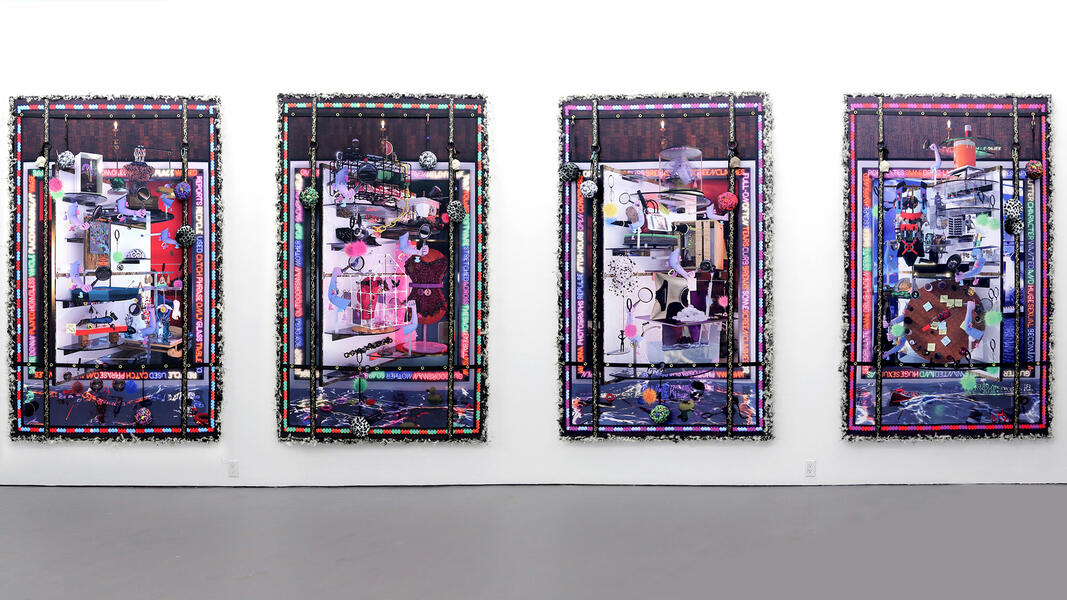 Local Atonement - A Nutshell Study of Unexplained Death
Local Atonement - A Nutshell Study of Unexplained DeathThese images can recall Monet Water Lily Paintings or Rothko’s Chapel. Again we use text as a border but more abstracted then the use of full sentences used in the last show.
In Kimbra’s narrative it is known her parents own an antique store. The paintings participate in this narrative while each shelf can be seen opening up into a portal space behind them.
The sense of control that comes with building and arranging a dollhouse had parallels to the world building aspects of the BOY’Dega website. And like these paintings we were looking for a density per square inch.
-
 Local Atonement - A Nutshell Study of Unexplained Death
Local Atonement - A Nutshell Study of Unexplained DeathThe show is split into three parts and is an expansion of Kimbra legacy, of one of the characters in BOY’Dega season 1.
The show was also a further investigation into some of our concerns explored in DUOX4Larkin.
This show deals with set dressing or staging through digital production.
-
Nutshell Trailer
-
 PRE - WANTED
PRE - WANTEDPRE-WANTED, 2016 Dye sublimation print on canvas with nylon webbbing, fur and printed pillows, tarred and feathered frame 92 x 56 inches
The portals in these paintings speak to the way one would move around the BOY’Dega website, there is a similar suggestion of time and compression and jump cuts.
-
 Local Atonement - A Nutshell Study of Unexplained Death (Installation view)
Local Atonement - A Nutshell Study of Unexplained Death (Installation view)In the main gallery there hangs eight paintings that function as a unit - a way of articulating a room or a panoramic experience.These words still come from the same BOY’Dega PDF and this time Deli lights frame the paintings and digital water floods each canvas intended to create a merging effect.
-
 PRE-LEROY (Detail)
PRE-LEROY (Detail)PRE-LEROY, 2016. Dye sublimation print on canvas with nylon webbbing, fur and printed pillows, tarred and feathered frame 92 x 56 inches
The Robert Morris poster is a piece of body art used to promote his 1974 exhibition. The photo was originally published in Artforum. We have always wanted to find a way to use this piece of promotion as a reference when by coincidence we realized our paintings we formatted in a similar way. Even the chain hung around his neck is reflected in the chain webbing that run horizontally down the work. BOY’Dega wiki text - formalizes the body of work
-
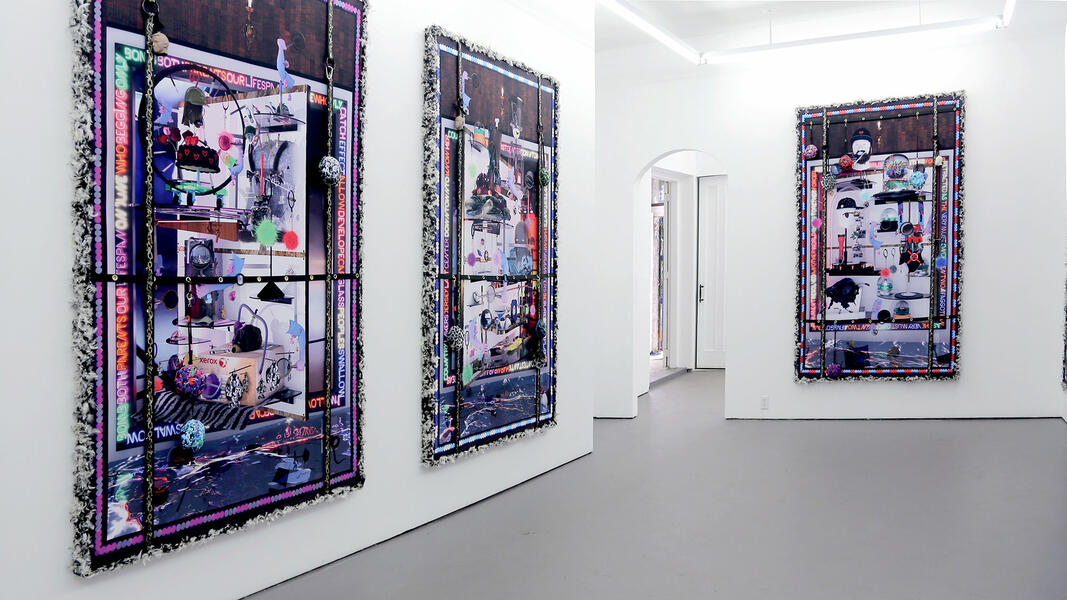 Local Atonement - A Nutshell Study of Unexplained Death (Installation view)
Local Atonement - A Nutshell Study of Unexplained Death (Installation view) -
 PRE-SOFTWARE (left) PRE-EYEBALL (right)
PRE-SOFTWARE (left) PRE-EYEBALL (right)The two paintings in the rear of the gallery are CGI renderings of Kimbra whose head has been turned into a porp.
References for this exhibition range from the NBC show Fear Factor where most phobias are compressed into a claustrophobic space to be on heightened display and the then
-
 PRE-EYEBALL (detail)
PRE-EYEBALL (detail) -
 Self with Self
Self with SelfDiptych, HD Video Loop. 2016
Starting off the exhibition, and visible from the street are two videos that run parallel and function under a loop. Self with Self is a video work where parenting is considered by non-parents as an enduring performance.
Janet & Walter Sondheim Exhibition
In Boy'dega the ensemble cast is an oscillating extension of its lead actor and becomes a metaphor for community and family. In the televisual web series its made explicit due to the ability to inhabit his body. He is a vessel and his friends become technologies extending his person. The lines of character, fan, author and actor gain fluidity to talk about the aims of successful collaboration. Girth Proof is an investigative stance on a subculture that talks about notions of access and exclusivity based on one's body-image. It explores things about ways one becomes disassociated from the group or find various points across its spectrum while still using narrative and the language of television as an investigative tool. We have deliberately chosen frats as the follow up social group to explore because the conversation has a dual implication in this work as both a homo erotic gesture, and a conversation around sexual violence whether through rape or hazing.
We wanted to design a project that could allow all these groups represented through forms to function in the same space as well as work towards the ways they imbue and complicate each other's narratives down the line.
-
BOY'Dega trailer
-
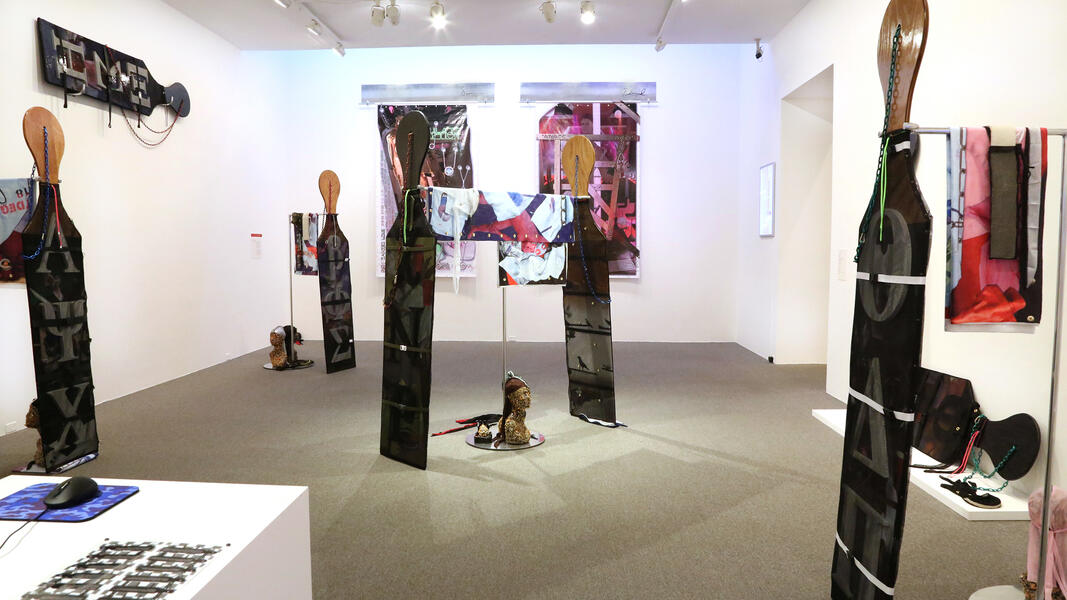 Installation View
Installation ViewThe paddles are styled in a BDSM-goth subculture fashion with straps chains and fasteners. There are 8 paddles that casually stand in and extend our original cast.
Durags have been customized similar to the Scrub’s in the DUOX4Larkin show. Zippers have been inserted to take them out of their conventional state in the world to create a subgroup, or a group even more specific while also allowing them to function on the level of an artwork.
The proximity to the sculpture garden and the Frat Houses of John’s Hopkins suggest elements of site specificity in the exhibition.
8' black stained wood paddle customized (in mesh, straps, 6' metal chains, and rock spray) du-rags with grommets, 6 printed towels, 2 6'x9' vinyls, 6 wig heads covered in a bird seed mixture and bar snacks covered in resin, 5 ceramic works dispersed through the installation 2015, Baltimore Museum of Art
-
 boydega-season-1-12.jpeg
boydega-season-1-12.jpegB:E4S presents itself as fan-fiction parlaying as an artwork both intended to inform one another by taking a Trojan Horse and trapping it in the droste effect. Distanciation, the supplemental, cultural practices, process/procedural, and self preservation cause further proliferation, engender new forms to present ideas of propagation, of reproduction, of mutation, of generation, and of moving from a place of origin to a Frankensteinian notion of selfhood.
-
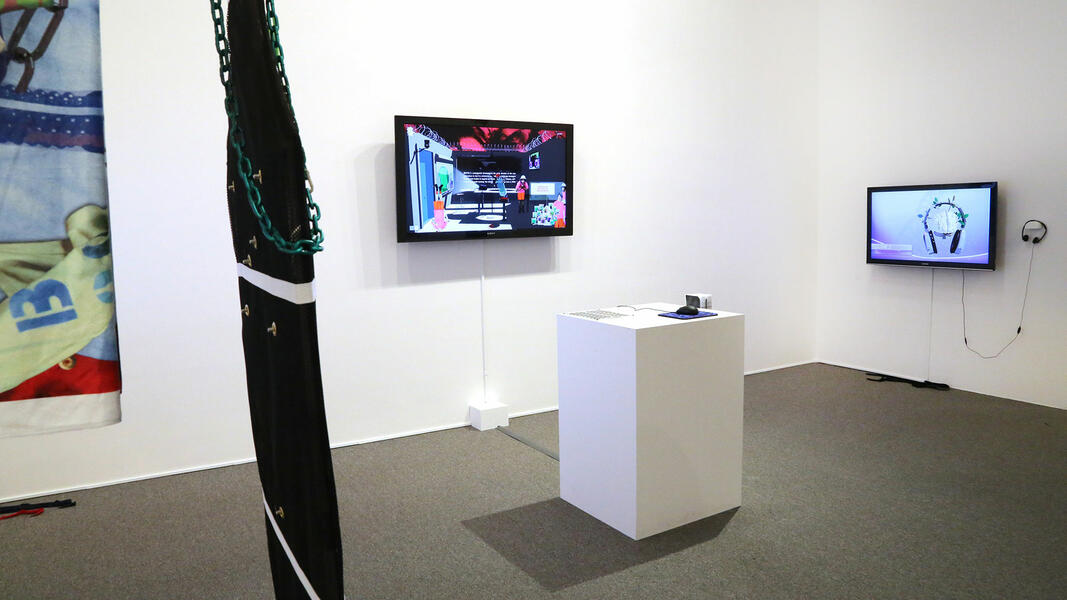 7A6A0119.jpeg
7A6A0119.jpegWe presented in the exhibition a low res take-away pamphlet that addresses our ideal User. In addressing someone who is attempting to use the website we attempt to move towards activating empathy from them in exchange for their time spent looking at the work.
The Ursula K Le Guin quote seen on the light box work, is introduced to address empathetic technology.
-
 Detail Image
Detail ImageThe towels in the exhibition function like printed puddles, mopping together haphazardly older and newer references in a concentrated source. Little elements congeal to make rags for the body or bodies.
8' black stained wood paddle customized (in mesh, straps, 6' metal chains, and rock spray) du-rags with grommets, 6 printed towels 2015, Baltimore Museum of Art
-
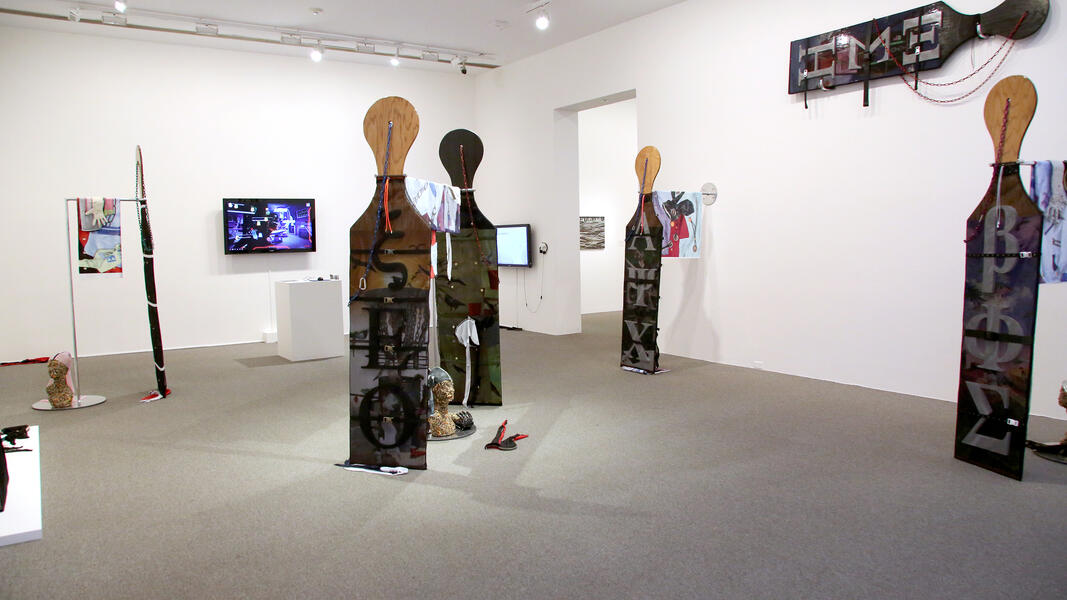 Installation View8' black stained wood paddle customized (in mesh, straps, 6' metal chains, and rock spray) du-rags with grommets, 6 printed towels, 2 6'x9' vinyls, 6 wigheads covered in a bird seed mixture and bar snacks covered in resin, 5 ceramic works dispersed through the installation, Three channel video work with interactive web component 2015, Baltimore Museum of Art
Installation View8' black stained wood paddle customized (in mesh, straps, 6' metal chains, and rock spray) du-rags with grommets, 6 printed towels, 2 6'x9' vinyls, 6 wigheads covered in a bird seed mixture and bar snacks covered in resin, 5 ceramic works dispersed through the installation, Three channel video work with interactive web component 2015, Baltimore Museum of Art -
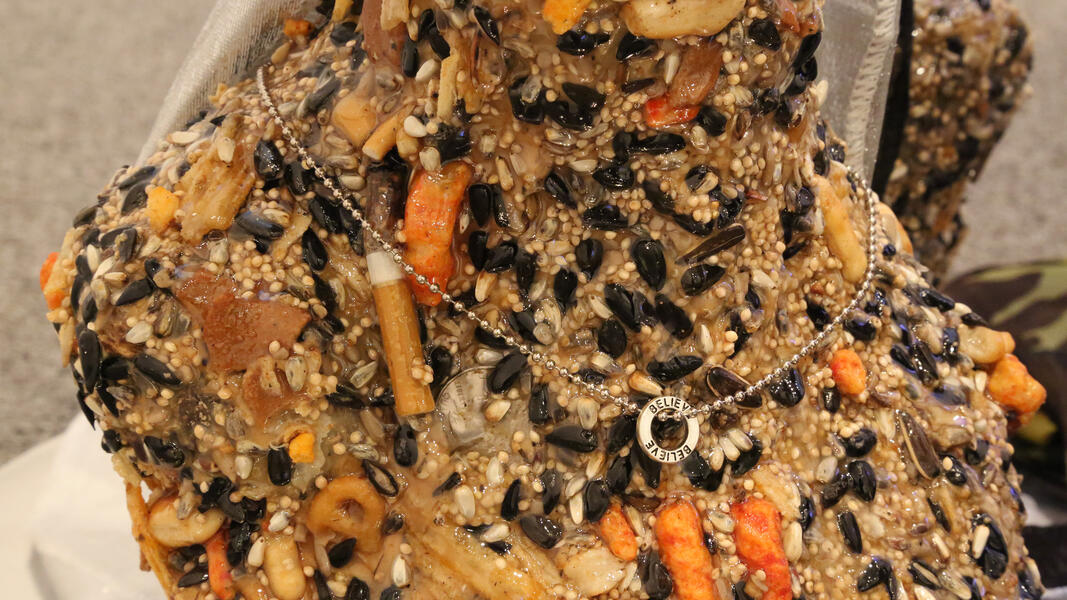 Detail Image6 wigheads covered in a bird seed mixture and bar snacks covered in resin, 2015, Baltimore Museum of Art
Detail Image6 wigheads covered in a bird seed mixture and bar snacks covered in resin, 2015, Baltimore Museum of Art -
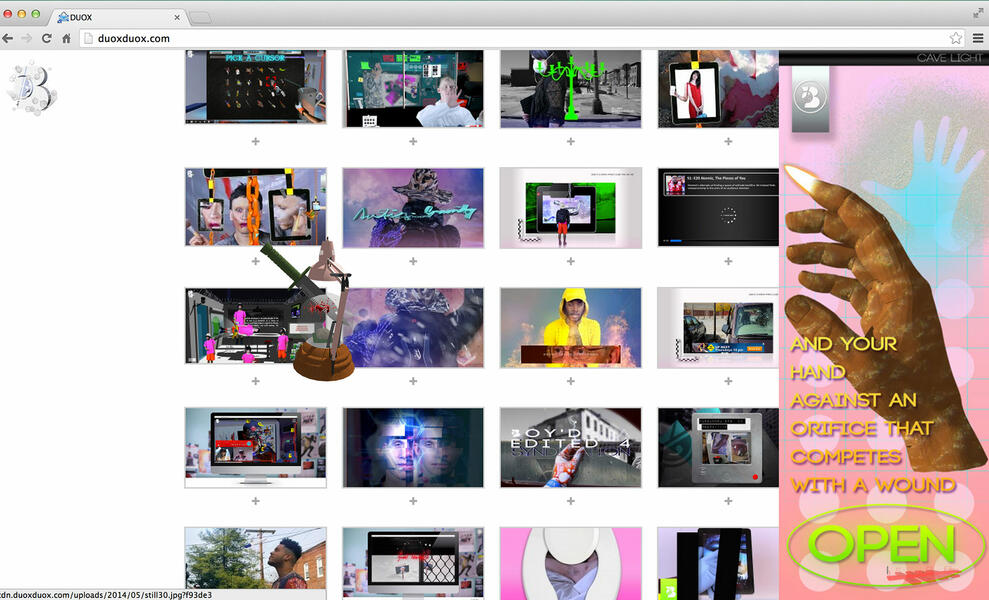 boydega-season-1-7.jpeg
boydega-season-1-7.jpegBoy’dega: Edited 4 Syndication is a website.
Our model posits the nature of interchangeability through a set of key roles in any show's canon. Those being, the character, the author, the fan and the actor. Our web project attempts to blur the distinctions between these roles in hopes of creating a form of security through obscurity.
The site is a supplemental to our tv show’s non-existence, a consciously chosen mirage based on aspects of HBO’s The Wire.
-
 BOY'Dega Season 2, Video Still
BOY'Dega Season 2, Video Still -
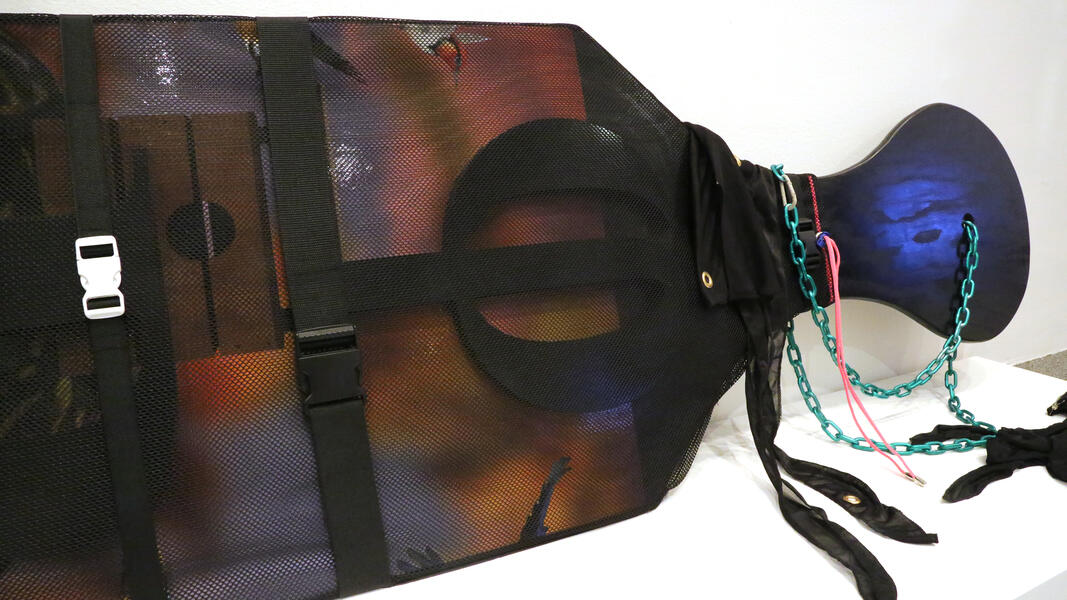 Frat Paddle 1-8(Detail) 8' black stained wood paddle customized (in mesh, straps, 6' metal chains, and rock spray) du-rags with grommets 2015, Baltimore Museum of Art
Frat Paddle 1-8(Detail) 8' black stained wood paddle customized (in mesh, straps, 6' metal chains, and rock spray) du-rags with grommets 2015, Baltimore Museum of Art
DUOX4Larkin
DUOX function's like a fast fashion brand (H&M) overlaying themselves and their methods onto Larkin Soap, a defunct company from the 19th Century. Adopting some old ideas and stretching others to an extreme, new productions emerge. Male Pregnancy, XL Look Books and The Gift Bags for all.
DUOX4Larkin draws on the historical example of the Larkin Company, a now defunct soap and home decorations company founded in the 19th Century. Housed in an administrative building designed by Frank Lloyd Wright, Larkin achieved notoriety for its endeavors to promote harmonious working conditions and “pure” values amongst its workforce, in synthesis with the purveyance of lifestyle solutions to its customers. Considering Larkin as a prescient Gesamstkunstwerk of branded product and corporate values, DUOX4Larkin incorporates arrangements of objects and images that relate to the changed notion of labor - overly designed and dysfunctional workstations, detoured workwear, customized commodities, and the use of screens for both display and concealment. The physical qualities of DUOX’s work in which related elements indicate hierarchies of “the simulated” and “the real”, build on the application of physiological ideals of cleanliness and hygiene within contemporary culture. Underlying processes of customization suggest both the standardizing of aesthetic choice, and its extension into the realm of biopolitics. The composite inhabitant of their workspaces is part health worker, part surrogate parent, part fashion victim.
-
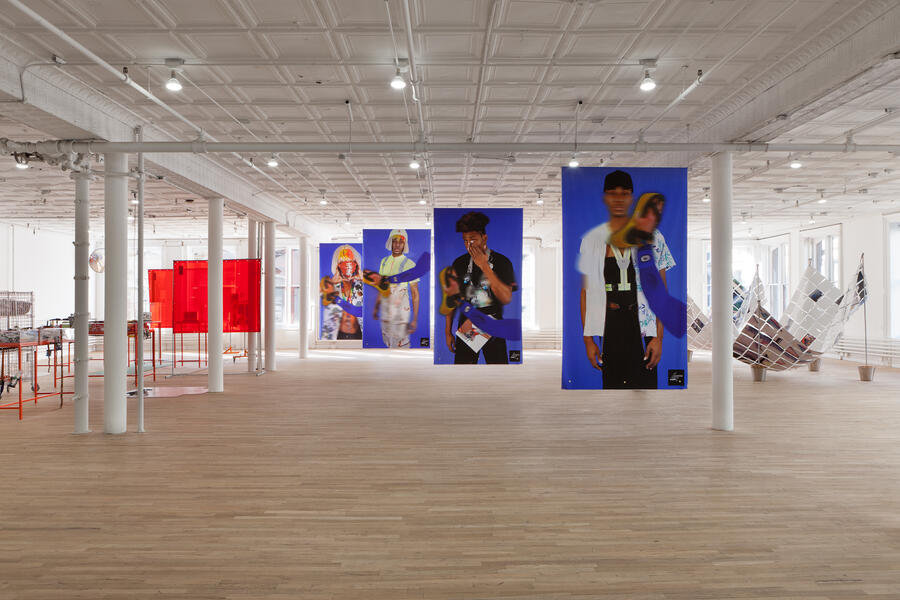 Installation viewDigital prints on silk, laminated digital prints, vitrines filled with various objects DUOX4Larkin is a solo exhibition consisting of three sculptures (from right to left: Cribs, XL Look Book and Break Room) that consider life from birth to death and (the) work in between. Focusing on the screen's ability to hold information, the work's surfaces are laminated, concealed, and preserved. The physical qualities of this work, in which related elements indicate hierarchies of “the simulated” and “the real,” build on the application of physiological ideals of cleanliness and hygiene within contemporary culture. Underlying processes of customization suggest both the standardizing of aesthetic choice and its extension into the realm of biopolitics. The composite inhabitant of these presented workspaces is part health worker, part surrogate parent, part fashion.
Installation viewDigital prints on silk, laminated digital prints, vitrines filled with various objects DUOX4Larkin is a solo exhibition consisting of three sculptures (from right to left: Cribs, XL Look Book and Break Room) that consider life from birth to death and (the) work in between. Focusing on the screen's ability to hold information, the work's surfaces are laminated, concealed, and preserved. The physical qualities of this work, in which related elements indicate hierarchies of “the simulated” and “the real,” build on the application of physiological ideals of cleanliness and hygiene within contemporary culture. Underlying processes of customization suggest both the standardizing of aesthetic choice and its extension into the realm of biopolitics. The composite inhabitant of these presented workspaces is part health worker, part surrogate parent, part fashion. -
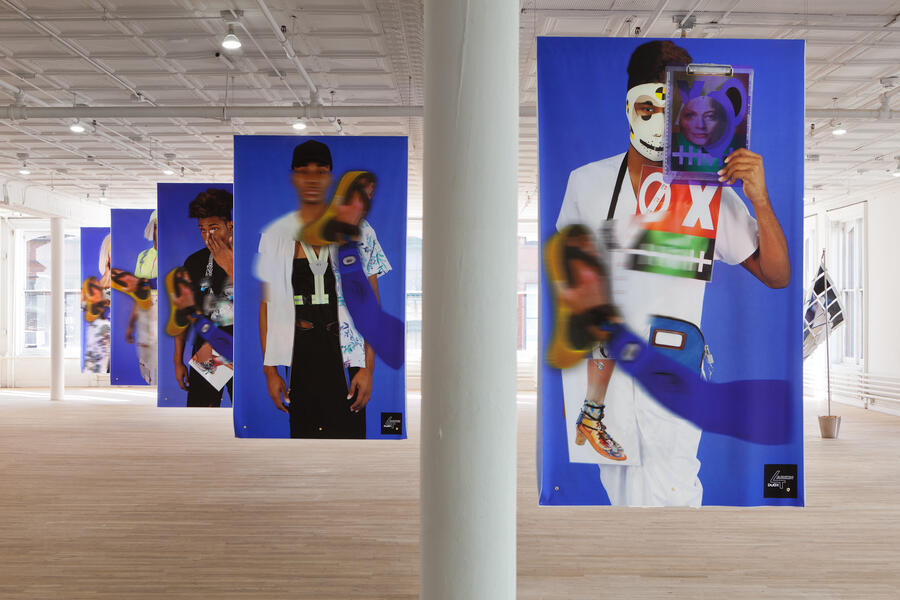 XL Lookbook (Detail)Double sided digital prints on silk. These photographs sprang from the true story of a female construction worker who dyed her bangs to match her safety vest. We were interested in ways people use customization to cope with even the most banal and precarious aspects of their lives.The show was initially called Customize Your Strife. We created a wardrobe by making alterations at the dry cleaners, adding zippers, creating slits, hems and patching up holes. These codified alterations operated like DNA that could easily be passed on to an adopted by a new designer/collaborator in the future.
XL Lookbook (Detail)Double sided digital prints on silk. These photographs sprang from the true story of a female construction worker who dyed her bangs to match her safety vest. We were interested in ways people use customization to cope with even the most banal and precarious aspects of their lives.The show was initially called Customize Your Strife. We created a wardrobe by making alterations at the dry cleaners, adding zippers, creating slits, hems and patching up holes. These codified alterations operated like DNA that could easily be passed on to an adopted by a new designer/collaborator in the future. -
 XL Lookbook (Reverse)
XL Lookbook (Reverse)Double sided digital prints on silk. A backside detail of XL Look Book prints are the most directly related to the show's title which is meant to invoke a fast fashion brand's collaboration with a highend designer (ex: Alexander Wang for H&M) Our interest was to create these images to function like a design studio that wants to establish and spread the company's vocabulary and planting a seed in a broader audience.
Water Lily table cut glass, water cooler, DVD case, metal stand. The third sculpture is a constellation of cases, vitrines, and signage referred to as the Break Room. This part of the exhibition considers the break room as a site that, though removed from mainstream production, is no less vital.
-
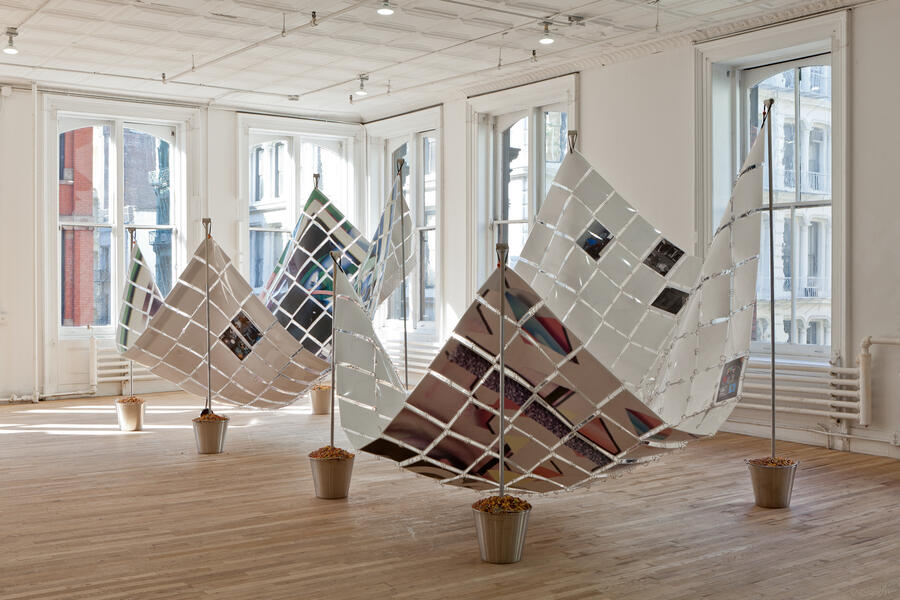 CribsLaminated digital prints, metal pipes, stainless steel buckets, cereal, metal rings. The first sculptures are the Cribs, which exist in various stages of erection. They are flexible cradles where new form is meant to take shape. This show is the birth of a character named BOY'D. Here his baby face is rendered from thousands of dots contained in each Rasterbated page. Our collaboration was looking at the creative possibility of male copregnancy and what could be conceived together under this unlikely circumstance.
CribsLaminated digital prints, metal pipes, stainless steel buckets, cereal, metal rings. The first sculptures are the Cribs, which exist in various stages of erection. They are flexible cradles where new form is meant to take shape. This show is the birth of a character named BOY'D. Here his baby face is rendered from thousands of dots contained in each Rasterbated page. Our collaboration was looking at the creative possibility of male copregnancy and what could be conceived together under this unlikely circumstance. -
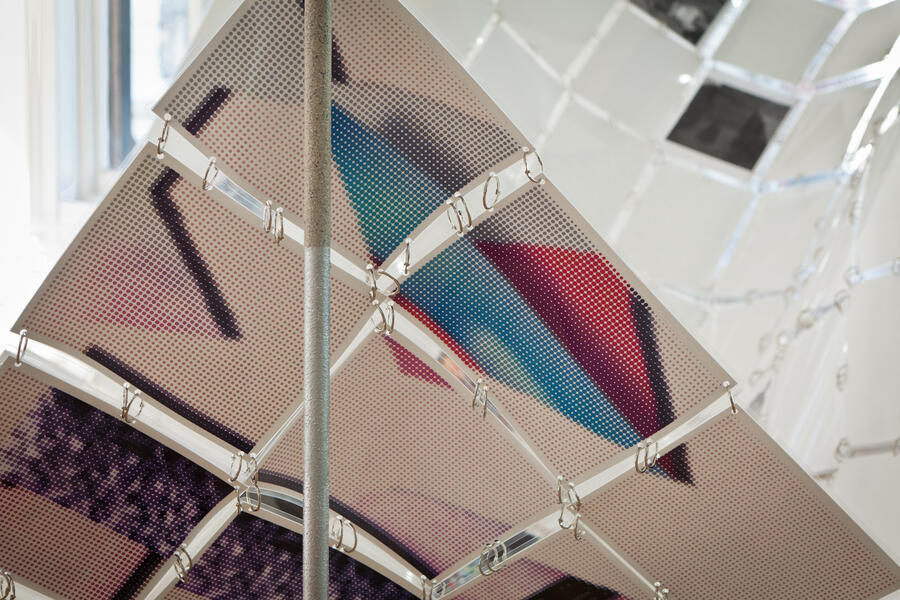 Cribs (Detail)The narrative around BOY'D was to create a protagonist out of parts, including Cervantes’s Don Quixote, Chaucer’s Wife of Bath, Gae?tan Dugas as the socalled Patient Zero, James Bond, and the ensemble cast of Oliver Stone’s Any Given Sunday. In this show, the press release is a letter of resignation appointing BOY'D to take over this environment.
Cribs (Detail)The narrative around BOY'D was to create a protagonist out of parts, including Cervantes’s Don Quixote, Chaucer’s Wife of Bath, Gae?tan Dugas as the socalled Patient Zero, James Bond, and the ensemble cast of Oliver Stone’s Any Given Sunday. In this show, the press release is a letter of resignation appointing BOY'D to take over this environment. -
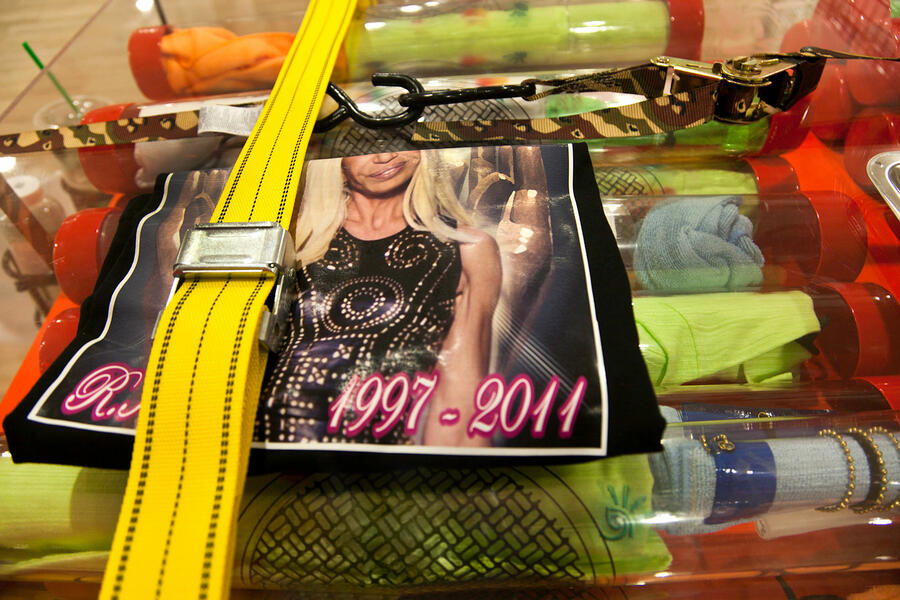 duox4larkin-donatella.jpeg
duox4larkin-donatella.jpegThe Larkin Company exemplified a workspace of benevolence that we thought framed the ideas we were investigating in the Breakroom section of the show. Vitrines of things preserved from the process are also considered modes of escape and joy.
-
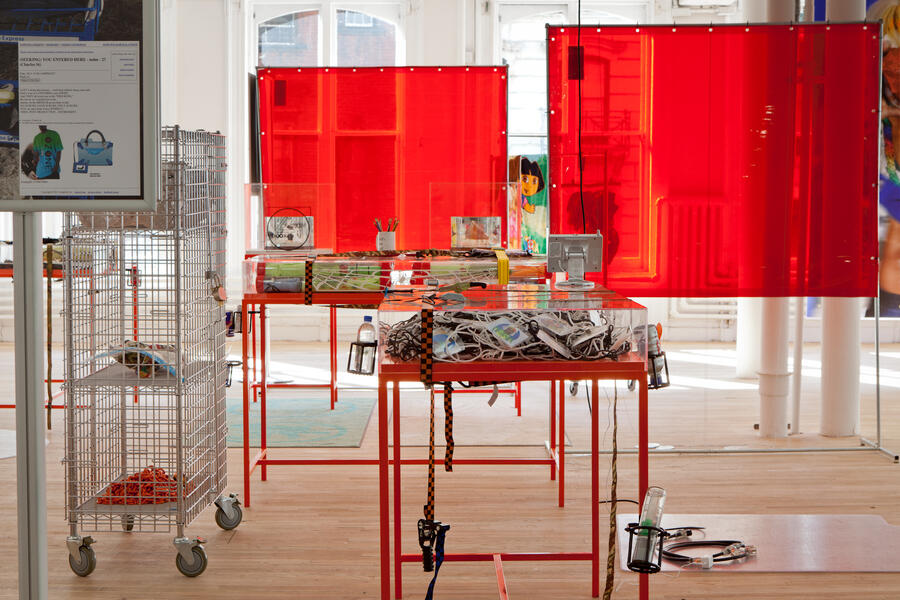 Break Room (Detail)Vitrines and screens. Here artifices of the show's ninemonth production are in casual communication: conch shells painted like sports equipment, two Dora the Explorer towels zipped together, a baby monitor filming a group of offsite Lava lamps, a net stuck with ID badges rests under glass, a coffee mug that announces World's Best Dad holds a set of pencils monogrammed with the exhibition's title, and a vitrine filled with seethrough vials containing with a terrycloth landing pad, a sanitizing pen, an uncommitted ID badge, and a change of clothes.
Break Room (Detail)Vitrines and screens. Here artifices of the show's ninemonth production are in casual communication: conch shells painted like sports equipment, two Dora the Explorer towels zipped together, a baby monitor filming a group of offsite Lava lamps, a net stuck with ID badges rests under glass, a coffee mug that announces World's Best Dad holds a set of pencils monogrammed with the exhibition's title, and a vitrine filled with seethrough vials containing with a terrycloth landing pad, a sanitizing pen, an uncommitted ID badge, and a change of clothes. -
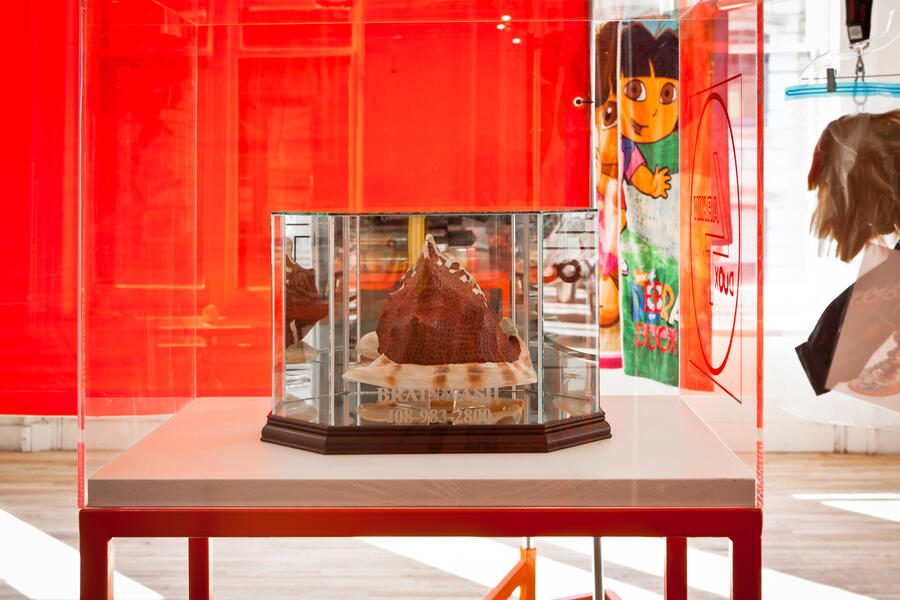 Break Room (Detail)Again we used Craigslist, this time announcing an m4m missed connection. The entire room—the entire exhibition—is collapsed into a single image by a convex mirror mounted in one upper corner of the gallery, a vantage point for the less adventurous visitor.
Break Room (Detail)Again we used Craigslist, this time announcing an m4m missed connection. The entire room—the entire exhibition—is collapsed into a single image by a convex mirror mounted in one upper corner of the gallery, a vantage point for the less adventurous visitor. -
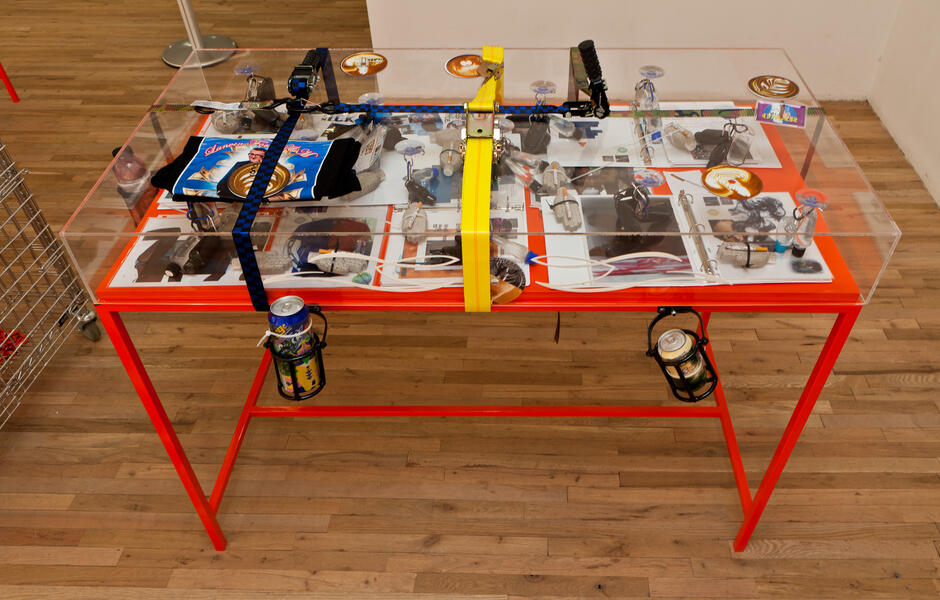 Break Room (Detail)Vitrines and screens.
Break Room (Detail)Vitrines and screens. -
PROMO WebFlyerPromotional website done as a supplemental item for the DUOX4Larkin project.
